Understanding Nonverbal Communication
VerifiedAdded on 2020/05/16
|26
|5185
|146
AI Summary
This assignment delves into the crucial role of nonverbal communication in human interactions. It examines various nonverbal cues such as facial expressions, body language, eye contact, and tone of voice, highlighting their significance in conveying emotions, intentions, and messages. The assignment also explores the influence of culture on nonverbal communication and how different societies interpret these cues. Understanding the complexities of nonverbal communication is essential for effective interpersonal relationships and successful communication.
Contribute Materials
Your contribution can guide someone’s learning journey. Share your
documents today.
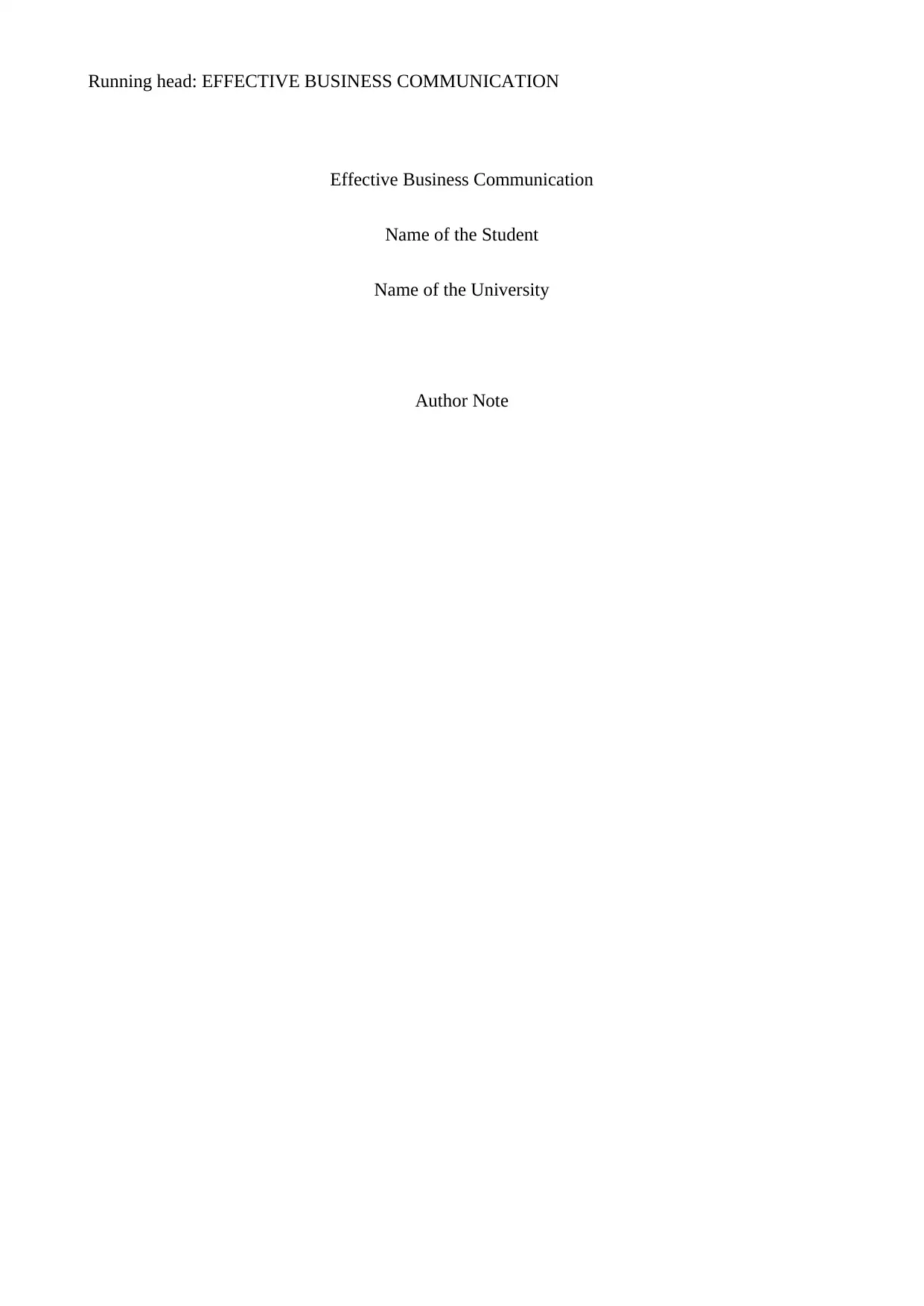
Running head: EFFECTIVE BUSINESS COMMUNICATION
Effective Business Communication
Name of the Student
Name of the University
Author Note
Effective Business Communication
Name of the Student
Name of the University
Author Note
Secure Best Marks with AI Grader
Need help grading? Try our AI Grader for instant feedback on your assignments.
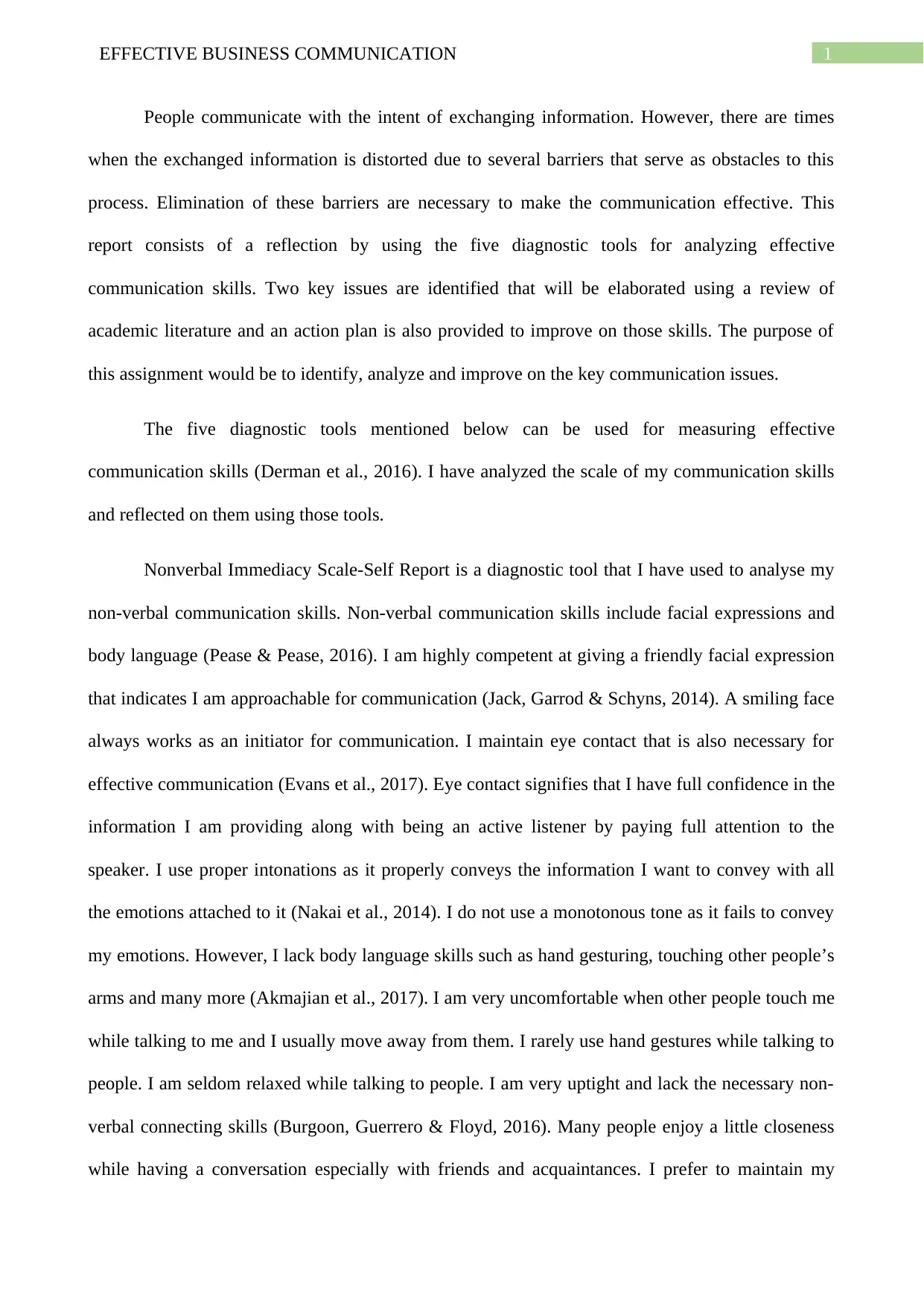
1EFFECTIVE BUSINESS COMMUNICATION
People communicate with the intent of exchanging information. However, there are times
when the exchanged information is distorted due to several barriers that serve as obstacles to this
process. Elimination of these barriers are necessary to make the communication effective. This
report consists of a reflection by using the five diagnostic tools for analyzing effective
communication skills. Two key issues are identified that will be elaborated using a review of
academic literature and an action plan is also provided to improve on those skills. The purpose of
this assignment would be to identify, analyze and improve on the key communication issues.
The five diagnostic tools mentioned below can be used for measuring effective
communication skills (Derman et al., 2016). I have analyzed the scale of my communication skills
and reflected on them using those tools.
Nonverbal Immediacy Scale-Self Report is a diagnostic tool that I have used to analyse my
non-verbal communication skills. Non-verbal communication skills include facial expressions and
body language (Pease & Pease, 2016). I am highly competent at giving a friendly facial expression
that indicates I am approachable for communication (Jack, Garrod & Schyns, 2014). A smiling face
always works as an initiator for communication. I maintain eye contact that is also necessary for
effective communication (Evans et al., 2017). Eye contact signifies that I have full confidence in the
information I am providing along with being an active listener by paying full attention to the
speaker. I use proper intonations as it properly conveys the information I want to convey with all
the emotions attached to it (Nakai et al., 2014). I do not use a monotonous tone as it fails to convey
my emotions. However, I lack body language skills such as hand gesturing, touching other people’s
arms and many more (Akmajian et al., 2017). I am very uncomfortable when other people touch me
while talking to me and I usually move away from them. I rarely use hand gestures while talking to
people. I am seldom relaxed while talking to people. I am very uptight and lack the necessary non-
verbal connecting skills (Burgoon, Guerrero & Floyd, 2016). Many people enjoy a little closeness
while having a conversation especially with friends and acquaintances. I prefer to maintain my
People communicate with the intent of exchanging information. However, there are times
when the exchanged information is distorted due to several barriers that serve as obstacles to this
process. Elimination of these barriers are necessary to make the communication effective. This
report consists of a reflection by using the five diagnostic tools for analyzing effective
communication skills. Two key issues are identified that will be elaborated using a review of
academic literature and an action plan is also provided to improve on those skills. The purpose of
this assignment would be to identify, analyze and improve on the key communication issues.
The five diagnostic tools mentioned below can be used for measuring effective
communication skills (Derman et al., 2016). I have analyzed the scale of my communication skills
and reflected on them using those tools.
Nonverbal Immediacy Scale-Self Report is a diagnostic tool that I have used to analyse my
non-verbal communication skills. Non-verbal communication skills include facial expressions and
body language (Pease & Pease, 2016). I am highly competent at giving a friendly facial expression
that indicates I am approachable for communication (Jack, Garrod & Schyns, 2014). A smiling face
always works as an initiator for communication. I maintain eye contact that is also necessary for
effective communication (Evans et al., 2017). Eye contact signifies that I have full confidence in the
information I am providing along with being an active listener by paying full attention to the
speaker. I use proper intonations as it properly conveys the information I want to convey with all
the emotions attached to it (Nakai et al., 2014). I do not use a monotonous tone as it fails to convey
my emotions. However, I lack body language skills such as hand gesturing, touching other people’s
arms and many more (Akmajian et al., 2017). I am very uncomfortable when other people touch me
while talking to me and I usually move away from them. I rarely use hand gestures while talking to
people. I am seldom relaxed while talking to people. I am very uptight and lack the necessary non-
verbal connecting skills (Burgoon, Guerrero & Floyd, 2016). Many people enjoy a little closeness
while having a conversation especially with friends and acquaintances. I prefer to maintain my
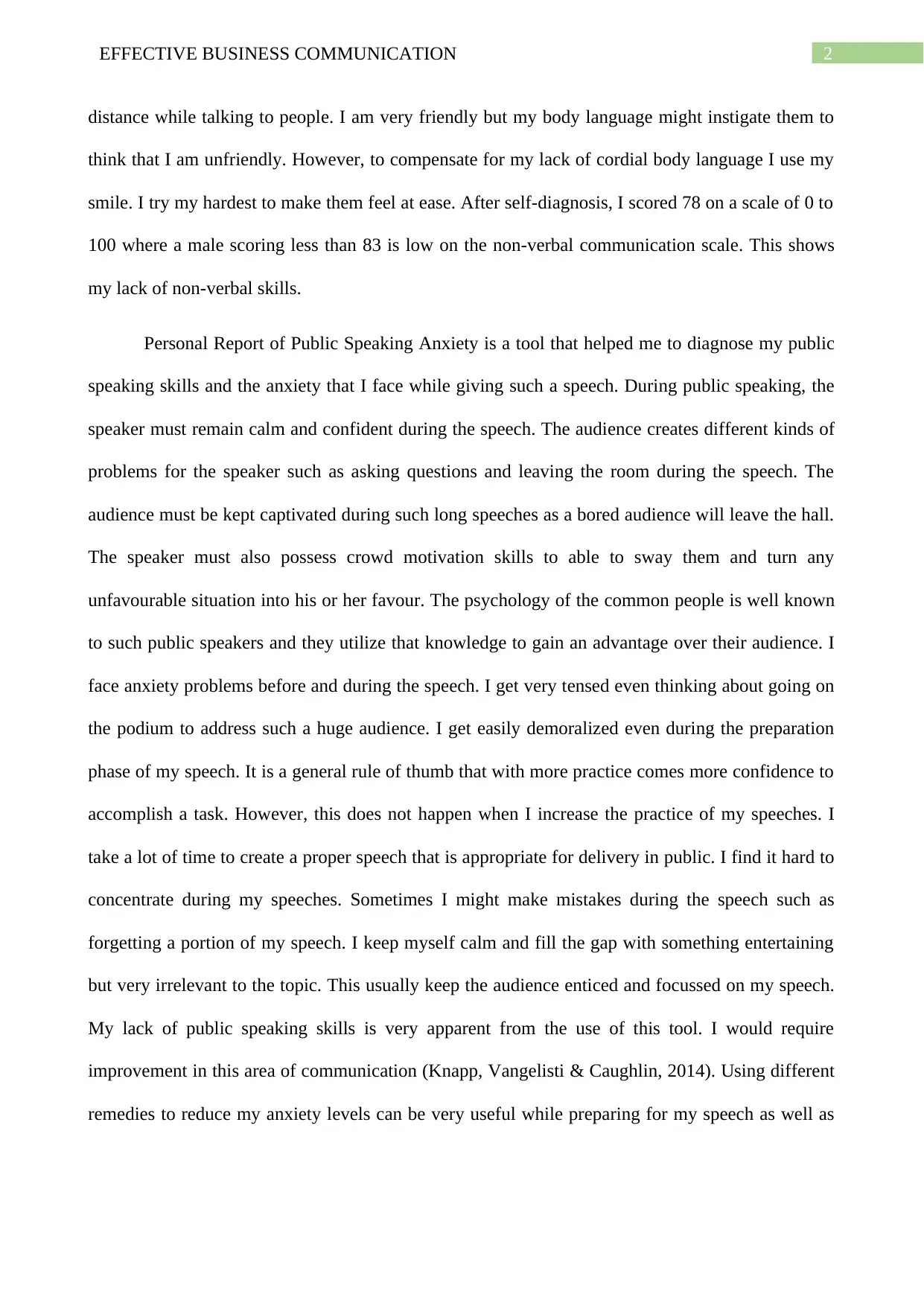
2EFFECTIVE BUSINESS COMMUNICATION
distance while talking to people. I am very friendly but my body language might instigate them to
think that I am unfriendly. However, to compensate for my lack of cordial body language I use my
smile. I try my hardest to make them feel at ease. After self-diagnosis, I scored 78 on a scale of 0 to
100 where a male scoring less than 83 is low on the non-verbal communication scale. This shows
my lack of non-verbal skills.
Personal Report of Public Speaking Anxiety is a tool that helped me to diagnose my public
speaking skills and the anxiety that I face while giving such a speech. During public speaking, the
speaker must remain calm and confident during the speech. The audience creates different kinds of
problems for the speaker such as asking questions and leaving the room during the speech. The
audience must be kept captivated during such long speeches as a bored audience will leave the hall.
The speaker must also possess crowd motivation skills to able to sway them and turn any
unfavourable situation into his or her favour. The psychology of the common people is well known
to such public speakers and they utilize that knowledge to gain an advantage over their audience. I
face anxiety problems before and during the speech. I get very tensed even thinking about going on
the podium to address such a huge audience. I get easily demoralized even during the preparation
phase of my speech. It is a general rule of thumb that with more practice comes more confidence to
accomplish a task. However, this does not happen when I increase the practice of my speeches. I
take a lot of time to create a proper speech that is appropriate for delivery in public. I find it hard to
concentrate during my speeches. Sometimes I might make mistakes during the speech such as
forgetting a portion of my speech. I keep myself calm and fill the gap with something entertaining
but very irrelevant to the topic. This usually keep the audience enticed and focussed on my speech.
My lack of public speaking skills is very apparent from the use of this tool. I would require
improvement in this area of communication (Knapp, Vangelisti & Caughlin, 2014). Using different
remedies to reduce my anxiety levels can be very useful while preparing for my speech as well as
distance while talking to people. I am very friendly but my body language might instigate them to
think that I am unfriendly. However, to compensate for my lack of cordial body language I use my
smile. I try my hardest to make them feel at ease. After self-diagnosis, I scored 78 on a scale of 0 to
100 where a male scoring less than 83 is low on the non-verbal communication scale. This shows
my lack of non-verbal skills.
Personal Report of Public Speaking Anxiety is a tool that helped me to diagnose my public
speaking skills and the anxiety that I face while giving such a speech. During public speaking, the
speaker must remain calm and confident during the speech. The audience creates different kinds of
problems for the speaker such as asking questions and leaving the room during the speech. The
audience must be kept captivated during such long speeches as a bored audience will leave the hall.
The speaker must also possess crowd motivation skills to able to sway them and turn any
unfavourable situation into his or her favour. The psychology of the common people is well known
to such public speakers and they utilize that knowledge to gain an advantage over their audience. I
face anxiety problems before and during the speech. I get very tensed even thinking about going on
the podium to address such a huge audience. I get easily demoralized even during the preparation
phase of my speech. It is a general rule of thumb that with more practice comes more confidence to
accomplish a task. However, this does not happen when I increase the practice of my speeches. I
take a lot of time to create a proper speech that is appropriate for delivery in public. I find it hard to
concentrate during my speeches. Sometimes I might make mistakes during the speech such as
forgetting a portion of my speech. I keep myself calm and fill the gap with something entertaining
but very irrelevant to the topic. This usually keep the audience enticed and focussed on my speech.
My lack of public speaking skills is very apparent from the use of this tool. I would require
improvement in this area of communication (Knapp, Vangelisti & Caughlin, 2014). Using different
remedies to reduce my anxiety levels can be very useful while preparing for my speech as well as
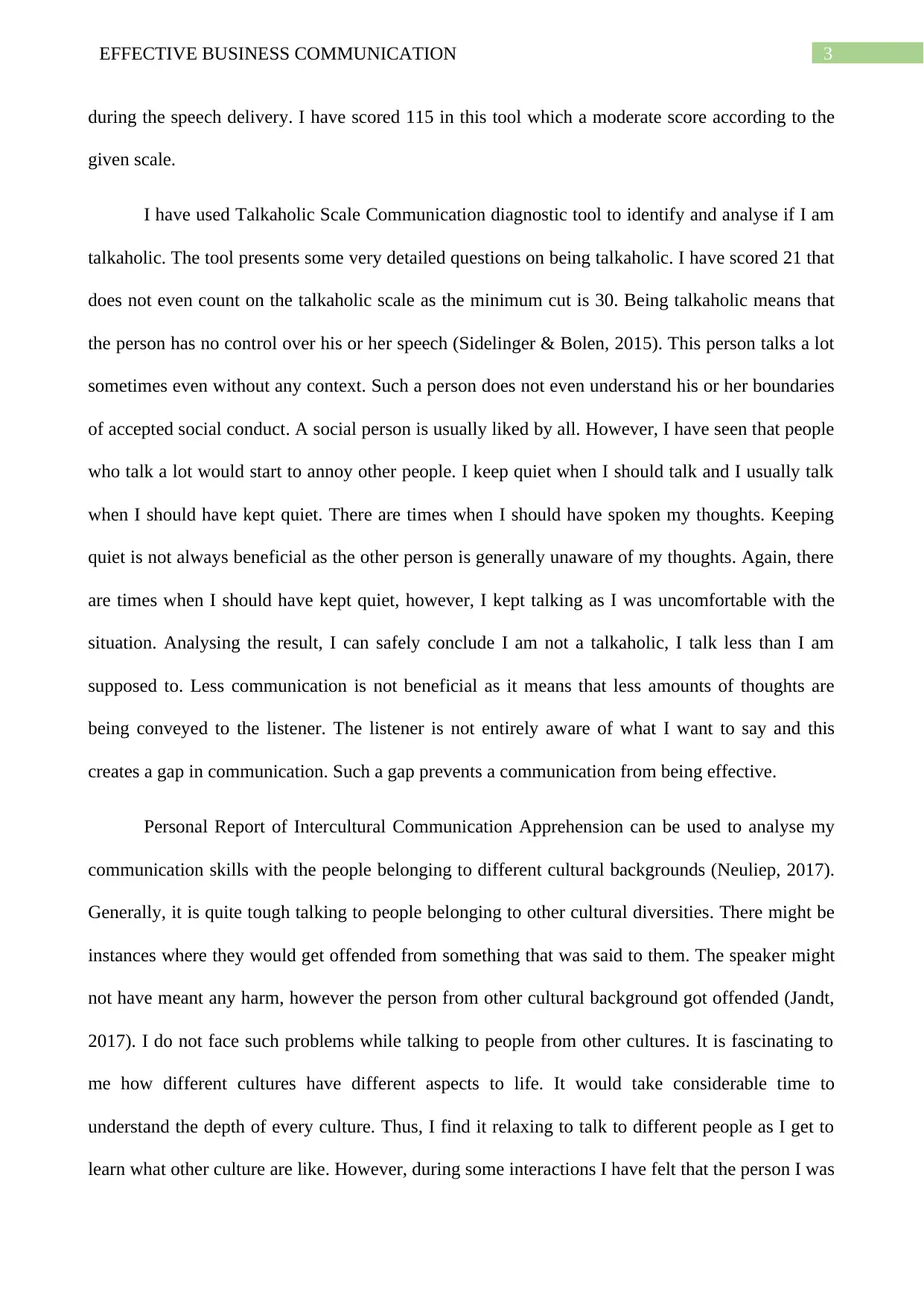
3EFFECTIVE BUSINESS COMMUNICATION
during the speech delivery. I have scored 115 in this tool which a moderate score according to the
given scale.
I have used Talkaholic Scale Communication diagnostic tool to identify and analyse if I am
talkaholic. The tool presents some very detailed questions on being talkaholic. I have scored 21 that
does not even count on the talkaholic scale as the minimum cut is 30. Being talkaholic means that
the person has no control over his or her speech (Sidelinger & Bolen, 2015). This person talks a lot
sometimes even without any context. Such a person does not even understand his or her boundaries
of accepted social conduct. A social person is usually liked by all. However, I have seen that people
who talk a lot would start to annoy other people. I keep quiet when I should talk and I usually talk
when I should have kept quiet. There are times when I should have spoken my thoughts. Keeping
quiet is not always beneficial as the other person is generally unaware of my thoughts. Again, there
are times when I should have kept quiet, however, I kept talking as I was uncomfortable with the
situation. Analysing the result, I can safely conclude I am not a talkaholic, I talk less than I am
supposed to. Less communication is not beneficial as it means that less amounts of thoughts are
being conveyed to the listener. The listener is not entirely aware of what I want to say and this
creates a gap in communication. Such a gap prevents a communication from being effective.
Personal Report of Intercultural Communication Apprehension can be used to analyse my
communication skills with the people belonging to different cultural backgrounds (Neuliep, 2017).
Generally, it is quite tough talking to people belonging to other cultural diversities. There might be
instances where they would get offended from something that was said to them. The speaker might
not have meant any harm, however the person from other cultural background got offended (Jandt,
2017). I do not face such problems while talking to people from other cultures. It is fascinating to
me how different cultures have different aspects to life. It would take considerable time to
understand the depth of every culture. Thus, I find it relaxing to talk to different people as I get to
learn what other culture are like. However, during some interactions I have felt that the person I was
during the speech delivery. I have scored 115 in this tool which a moderate score according to the
given scale.
I have used Talkaholic Scale Communication diagnostic tool to identify and analyse if I am
talkaholic. The tool presents some very detailed questions on being talkaholic. I have scored 21 that
does not even count on the talkaholic scale as the minimum cut is 30. Being talkaholic means that
the person has no control over his or her speech (Sidelinger & Bolen, 2015). This person talks a lot
sometimes even without any context. Such a person does not even understand his or her boundaries
of accepted social conduct. A social person is usually liked by all. However, I have seen that people
who talk a lot would start to annoy other people. I keep quiet when I should talk and I usually talk
when I should have kept quiet. There are times when I should have spoken my thoughts. Keeping
quiet is not always beneficial as the other person is generally unaware of my thoughts. Again, there
are times when I should have kept quiet, however, I kept talking as I was uncomfortable with the
situation. Analysing the result, I can safely conclude I am not a talkaholic, I talk less than I am
supposed to. Less communication is not beneficial as it means that less amounts of thoughts are
being conveyed to the listener. The listener is not entirely aware of what I want to say and this
creates a gap in communication. Such a gap prevents a communication from being effective.
Personal Report of Intercultural Communication Apprehension can be used to analyse my
communication skills with the people belonging to different cultural backgrounds (Neuliep, 2017).
Generally, it is quite tough talking to people belonging to other cultural diversities. There might be
instances where they would get offended from something that was said to them. The speaker might
not have meant any harm, however the person from other cultural background got offended (Jandt,
2017). I do not face such problems while talking to people from other cultures. It is fascinating to
me how different cultures have different aspects to life. It would take considerable time to
understand the depth of every culture. Thus, I find it relaxing to talk to different people as I get to
learn what other culture are like. However, during some interactions I have felt that the person I was
Secure Best Marks with AI Grader
Need help grading? Try our AI Grader for instant feedback on your assignments.
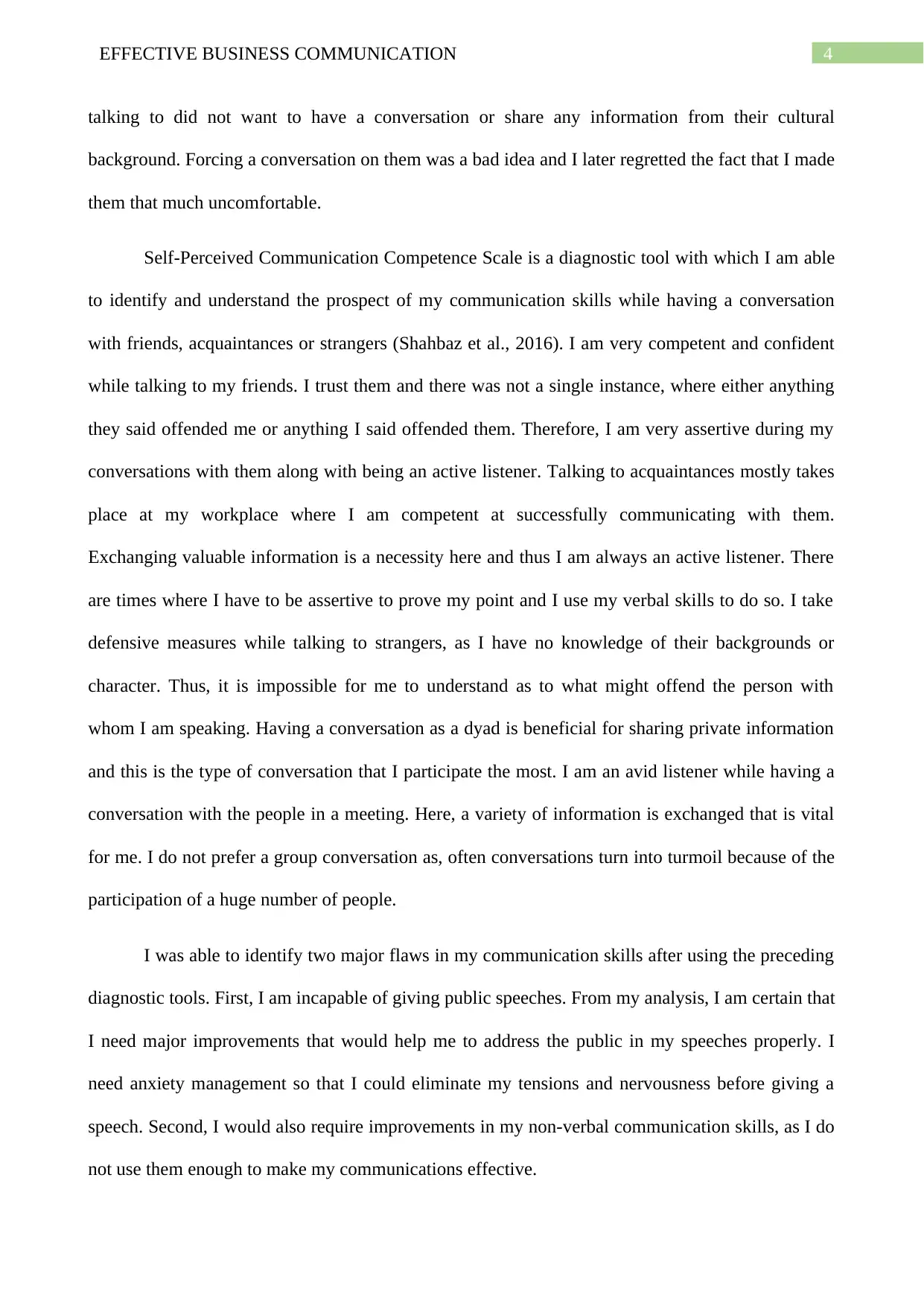
4EFFECTIVE BUSINESS COMMUNICATION
talking to did not want to have a conversation or share any information from their cultural
background. Forcing a conversation on them was a bad idea and I later regretted the fact that I made
them that much uncomfortable.
Self-Perceived Communication Competence Scale is a diagnostic tool with which I am able
to identify and understand the prospect of my communication skills while having a conversation
with friends, acquaintances or strangers (Shahbaz et al., 2016). I am very competent and confident
while talking to my friends. I trust them and there was not a single instance, where either anything
they said offended me or anything I said offended them. Therefore, I am very assertive during my
conversations with them along with being an active listener. Talking to acquaintances mostly takes
place at my workplace where I am competent at successfully communicating with them.
Exchanging valuable information is a necessity here and thus I am always an active listener. There
are times where I have to be assertive to prove my point and I use my verbal skills to do so. I take
defensive measures while talking to strangers, as I have no knowledge of their backgrounds or
character. Thus, it is impossible for me to understand as to what might offend the person with
whom I am speaking. Having a conversation as a dyad is beneficial for sharing private information
and this is the type of conversation that I participate the most. I am an avid listener while having a
conversation with the people in a meeting. Here, a variety of information is exchanged that is vital
for me. I do not prefer a group conversation as, often conversations turn into turmoil because of the
participation of a huge number of people.
I was able to identify two major flaws in my communication skills after using the preceding
diagnostic tools. First, I am incapable of giving public speeches. From my analysis, I am certain that
I need major improvements that would help me to address the public in my speeches properly. I
need anxiety management so that I could eliminate my tensions and nervousness before giving a
speech. Second, I would also require improvements in my non-verbal communication skills, as I do
not use them enough to make my communications effective.
talking to did not want to have a conversation or share any information from their cultural
background. Forcing a conversation on them was a bad idea and I later regretted the fact that I made
them that much uncomfortable.
Self-Perceived Communication Competence Scale is a diagnostic tool with which I am able
to identify and understand the prospect of my communication skills while having a conversation
with friends, acquaintances or strangers (Shahbaz et al., 2016). I am very competent and confident
while talking to my friends. I trust them and there was not a single instance, where either anything
they said offended me or anything I said offended them. Therefore, I am very assertive during my
conversations with them along with being an active listener. Talking to acquaintances mostly takes
place at my workplace where I am competent at successfully communicating with them.
Exchanging valuable information is a necessity here and thus I am always an active listener. There
are times where I have to be assertive to prove my point and I use my verbal skills to do so. I take
defensive measures while talking to strangers, as I have no knowledge of their backgrounds or
character. Thus, it is impossible for me to understand as to what might offend the person with
whom I am speaking. Having a conversation as a dyad is beneficial for sharing private information
and this is the type of conversation that I participate the most. I am an avid listener while having a
conversation with the people in a meeting. Here, a variety of information is exchanged that is vital
for me. I do not prefer a group conversation as, often conversations turn into turmoil because of the
participation of a huge number of people.
I was able to identify two major flaws in my communication skills after using the preceding
diagnostic tools. First, I am incapable of giving public speeches. From my analysis, I am certain that
I need major improvements that would help me to address the public in my speeches properly. I
need anxiety management so that I could eliminate my tensions and nervousness before giving a
speech. Second, I would also require improvements in my non-verbal communication skills, as I do
not use them enough to make my communications effective.

5EFFECTIVE BUSINESS COMMUNICATION
I would like to discuss two professional interactions from the last twelve months where my
lack of communication skills affected my interactions. There was once when I was unable to present
a good motivational speech to my colleges in one of the seminars at my company. My lack of
public speaking skills was evident from this instance. Another time was when I could not convey
my feelings of empathy to one of my colleagues who was about to leave the company that day. It
was evident that my lack of non-verbal communication skills held me back in this scenario as
touching the shoulders or arms of my colleague would have meant that I am showing my empathy
(Koegel et al., 2016).
In this literature review, I would be analyzing different literature and elaborate on the two
problems that I identified on the preceding section of this assignment.
Effectively delivering a speech to the public is defined as public speaking (Chen et al.,
2014). These speeches can be either entertaining or informative depending on the topics and
situations (Apostol-Mates & Barbu, 2017). A structured speech must be delivered with confidence,
as the public has a volatile nature and can get easily distracted by minute errors in the speech.
Anxiety diminishes the confidence of a speaker that in turn decreases the quality of the speech
(Taylor, 2014). A public speech would seem dull if the speaker is tensed during the speech. The
speaker might even face problems where he or she fails to recollect the speech that he or she had
prepared as soon as they stand on the podium. This type of behaviors generally occur due to anxiety
and must be eliminated using anxiety management (Mawson, 2017). Theoretically, such a problem
can be solved very easily by practicing the prepared speech several times alone and in front of a
mirror to practice the facial expressions and body language as well. The speaker must speak
captivatingly in order to draw the attention of the crowd and then maintain it at peak levels
(Carnegie, 2017). A good leader has the necessary skills to impart motivation. However, nurturing
leadership skills is very difficult especially among the young generations as they have less life
experience (Chen & Rybak, 2017). A crowd can be addressed in a proper fashion only if the
I would like to discuss two professional interactions from the last twelve months where my
lack of communication skills affected my interactions. There was once when I was unable to present
a good motivational speech to my colleges in one of the seminars at my company. My lack of
public speaking skills was evident from this instance. Another time was when I could not convey
my feelings of empathy to one of my colleagues who was about to leave the company that day. It
was evident that my lack of non-verbal communication skills held me back in this scenario as
touching the shoulders or arms of my colleague would have meant that I am showing my empathy
(Koegel et al., 2016).
In this literature review, I would be analyzing different literature and elaborate on the two
problems that I identified on the preceding section of this assignment.
Effectively delivering a speech to the public is defined as public speaking (Chen et al.,
2014). These speeches can be either entertaining or informative depending on the topics and
situations (Apostol-Mates & Barbu, 2017). A structured speech must be delivered with confidence,
as the public has a volatile nature and can get easily distracted by minute errors in the speech.
Anxiety diminishes the confidence of a speaker that in turn decreases the quality of the speech
(Taylor, 2014). A public speech would seem dull if the speaker is tensed during the speech. The
speaker might even face problems where he or she fails to recollect the speech that he or she had
prepared as soon as they stand on the podium. This type of behaviors generally occur due to anxiety
and must be eliminated using anxiety management (Mawson, 2017). Theoretically, such a problem
can be solved very easily by practicing the prepared speech several times alone and in front of a
mirror to practice the facial expressions and body language as well. The speaker must speak
captivatingly in order to draw the attention of the crowd and then maintain it at peak levels
(Carnegie, 2017). A good leader has the necessary skills to impart motivation. However, nurturing
leadership skills is very difficult especially among the young generations as they have less life
experience (Chen & Rybak, 2017). A crowd can be addressed in a proper fashion only if the
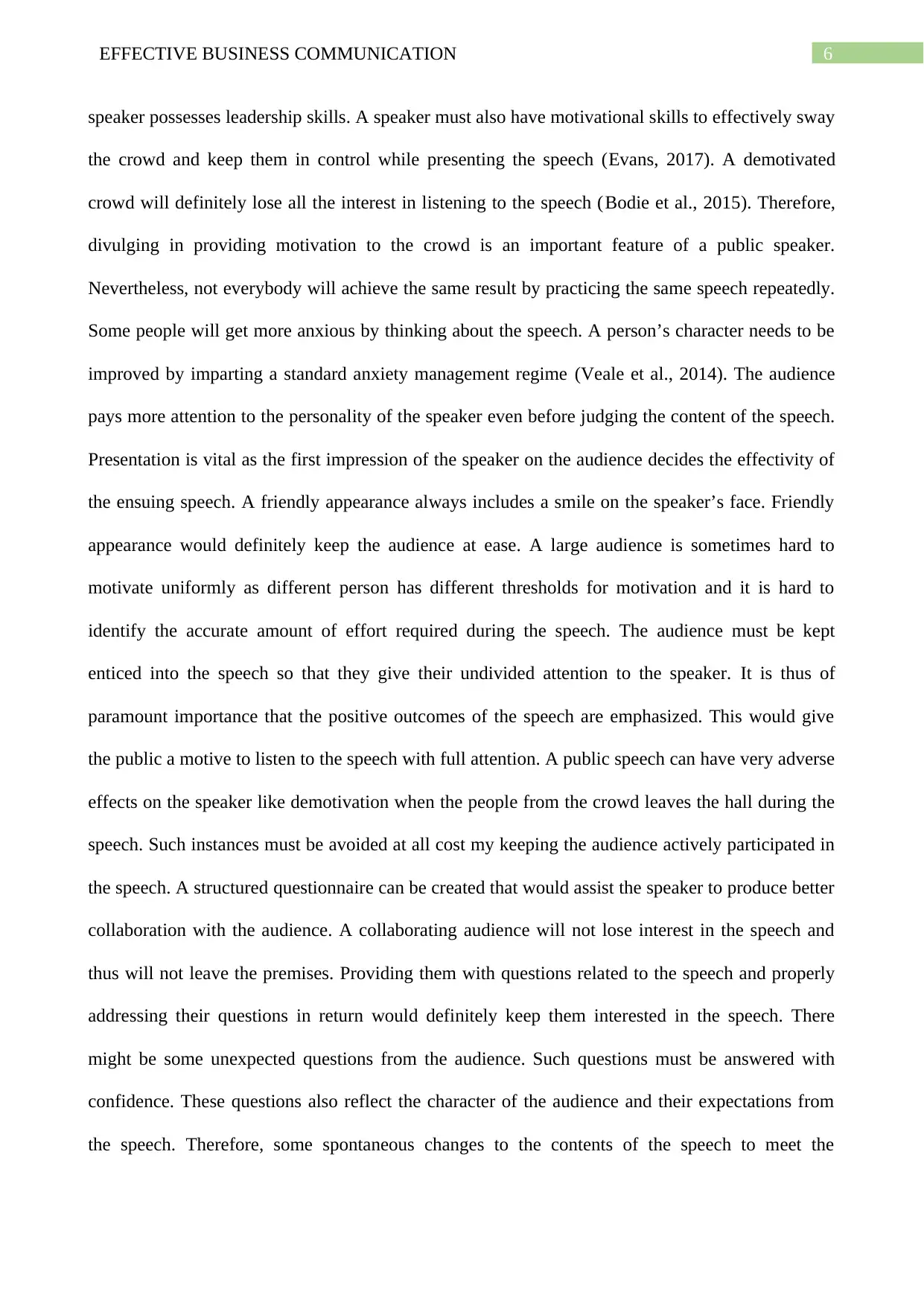
6EFFECTIVE BUSINESS COMMUNICATION
speaker possesses leadership skills. A speaker must also have motivational skills to effectively sway
the crowd and keep them in control while presenting the speech (Evans, 2017). A demotivated
crowd will definitely lose all the interest in listening to the speech (Bodie et al., 2015). Therefore,
divulging in providing motivation to the crowd is an important feature of a public speaker.
Nevertheless, not everybody will achieve the same result by practicing the same speech repeatedly.
Some people will get more anxious by thinking about the speech. A person’s character needs to be
improved by imparting a standard anxiety management regime (Veale et al., 2014). The audience
pays more attention to the personality of the speaker even before judging the content of the speech.
Presentation is vital as the first impression of the speaker on the audience decides the effectivity of
the ensuing speech. A friendly appearance always includes a smile on the speaker’s face. Friendly
appearance would definitely keep the audience at ease. A large audience is sometimes hard to
motivate uniformly as different person has different thresholds for motivation and it is hard to
identify the accurate amount of effort required during the speech. The audience must be kept
enticed into the speech so that they give their undivided attention to the speaker. It is thus of
paramount importance that the positive outcomes of the speech are emphasized. This would give
the public a motive to listen to the speech with full attention. A public speech can have very adverse
effects on the speaker like demotivation when the people from the crowd leaves the hall during the
speech. Such instances must be avoided at all cost my keeping the audience actively participated in
the speech. A structured questionnaire can be created that would assist the speaker to produce better
collaboration with the audience. A collaborating audience will not lose interest in the speech and
thus will not leave the premises. Providing them with questions related to the speech and properly
addressing their questions in return would definitely keep them interested in the speech. There
might be some unexpected questions from the audience. Such questions must be answered with
confidence. These questions also reflect the character of the audience and their expectations from
the speech. Therefore, some spontaneous changes to the contents of the speech to meet the
speaker possesses leadership skills. A speaker must also have motivational skills to effectively sway
the crowd and keep them in control while presenting the speech (Evans, 2017). A demotivated
crowd will definitely lose all the interest in listening to the speech (Bodie et al., 2015). Therefore,
divulging in providing motivation to the crowd is an important feature of a public speaker.
Nevertheless, not everybody will achieve the same result by practicing the same speech repeatedly.
Some people will get more anxious by thinking about the speech. A person’s character needs to be
improved by imparting a standard anxiety management regime (Veale et al., 2014). The audience
pays more attention to the personality of the speaker even before judging the content of the speech.
Presentation is vital as the first impression of the speaker on the audience decides the effectivity of
the ensuing speech. A friendly appearance always includes a smile on the speaker’s face. Friendly
appearance would definitely keep the audience at ease. A large audience is sometimes hard to
motivate uniformly as different person has different thresholds for motivation and it is hard to
identify the accurate amount of effort required during the speech. The audience must be kept
enticed into the speech so that they give their undivided attention to the speaker. It is thus of
paramount importance that the positive outcomes of the speech are emphasized. This would give
the public a motive to listen to the speech with full attention. A public speech can have very adverse
effects on the speaker like demotivation when the people from the crowd leaves the hall during the
speech. Such instances must be avoided at all cost my keeping the audience actively participated in
the speech. A structured questionnaire can be created that would assist the speaker to produce better
collaboration with the audience. A collaborating audience will not lose interest in the speech and
thus will not leave the premises. Providing them with questions related to the speech and properly
addressing their questions in return would definitely keep them interested in the speech. There
might be some unexpected questions from the audience. Such questions must be answered with
confidence. These questions also reflect the character of the audience and their expectations from
the speech. Therefore, some spontaneous changes to the contents of the speech to meet the
Paraphrase This Document
Need a fresh take? Get an instant paraphrase of this document with our AI Paraphraser
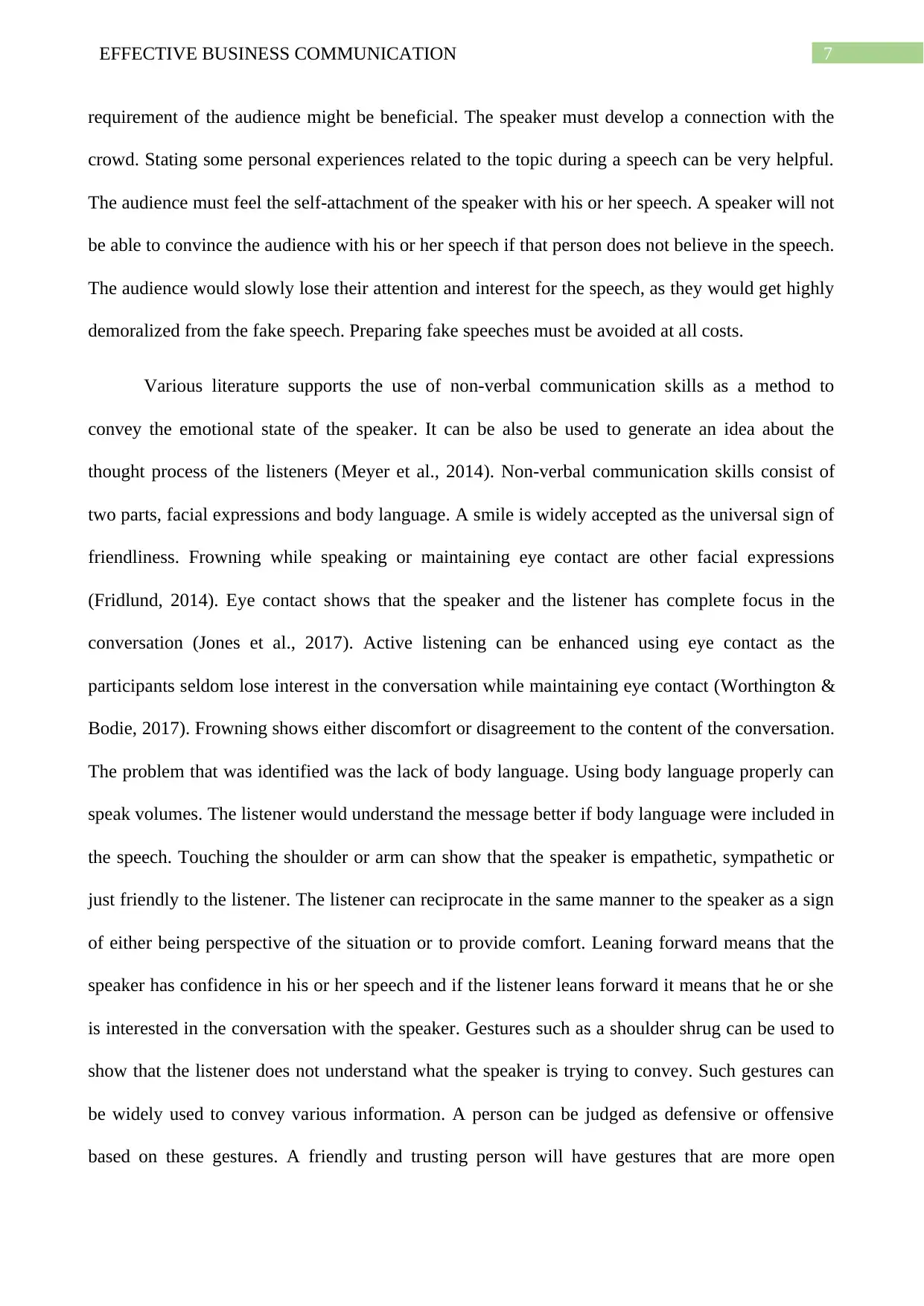
7EFFECTIVE BUSINESS COMMUNICATION
requirement of the audience might be beneficial. The speaker must develop a connection with the
crowd. Stating some personal experiences related to the topic during a speech can be very helpful.
The audience must feel the self-attachment of the speaker with his or her speech. A speaker will not
be able to convince the audience with his or her speech if that person does not believe in the speech.
The audience would slowly lose their attention and interest for the speech, as they would get highly
demoralized from the fake speech. Preparing fake speeches must be avoided at all costs.
Various literature supports the use of non-verbal communication skills as a method to
convey the emotional state of the speaker. It can be also be used to generate an idea about the
thought process of the listeners (Meyer et al., 2014). Non-verbal communication skills consist of
two parts, facial expressions and body language. A smile is widely accepted as the universal sign of
friendliness. Frowning while speaking or maintaining eye contact are other facial expressions
(Fridlund, 2014). Eye contact shows that the speaker and the listener has complete focus in the
conversation (Jones et al., 2017). Active listening can be enhanced using eye contact as the
participants seldom lose interest in the conversation while maintaining eye contact (Worthington &
Bodie, 2017). Frowning shows either discomfort or disagreement to the content of the conversation.
The problem that was identified was the lack of body language. Using body language properly can
speak volumes. The listener would understand the message better if body language were included in
the speech. Touching the shoulder or arm can show that the speaker is empathetic, sympathetic or
just friendly to the listener. The listener can reciprocate in the same manner to the speaker as a sign
of either being perspective of the situation or to provide comfort. Leaning forward means that the
speaker has confidence in his or her speech and if the listener leans forward it means that he or she
is interested in the conversation with the speaker. Gestures such as a shoulder shrug can be used to
show that the listener does not understand what the speaker is trying to convey. Such gestures can
be widely used to convey various information. A person can be judged as defensive or offensive
based on these gestures. A friendly and trusting person will have gestures that are more open
requirement of the audience might be beneficial. The speaker must develop a connection with the
crowd. Stating some personal experiences related to the topic during a speech can be very helpful.
The audience must feel the self-attachment of the speaker with his or her speech. A speaker will not
be able to convince the audience with his or her speech if that person does not believe in the speech.
The audience would slowly lose their attention and interest for the speech, as they would get highly
demoralized from the fake speech. Preparing fake speeches must be avoided at all costs.
Various literature supports the use of non-verbal communication skills as a method to
convey the emotional state of the speaker. It can be also be used to generate an idea about the
thought process of the listeners (Meyer et al., 2014). Non-verbal communication skills consist of
two parts, facial expressions and body language. A smile is widely accepted as the universal sign of
friendliness. Frowning while speaking or maintaining eye contact are other facial expressions
(Fridlund, 2014). Eye contact shows that the speaker and the listener has complete focus in the
conversation (Jones et al., 2017). Active listening can be enhanced using eye contact as the
participants seldom lose interest in the conversation while maintaining eye contact (Worthington &
Bodie, 2017). Frowning shows either discomfort or disagreement to the content of the conversation.
The problem that was identified was the lack of body language. Using body language properly can
speak volumes. The listener would understand the message better if body language were included in
the speech. Touching the shoulder or arm can show that the speaker is empathetic, sympathetic or
just friendly to the listener. The listener can reciprocate in the same manner to the speaker as a sign
of either being perspective of the situation or to provide comfort. Leaning forward means that the
speaker has confidence in his or her speech and if the listener leans forward it means that he or she
is interested in the conversation with the speaker. Gestures such as a shoulder shrug can be used to
show that the listener does not understand what the speaker is trying to convey. Such gestures can
be widely used to convey various information. A person can be judged as defensive or offensive
based on these gestures. A friendly and trusting person will have gestures that are more open
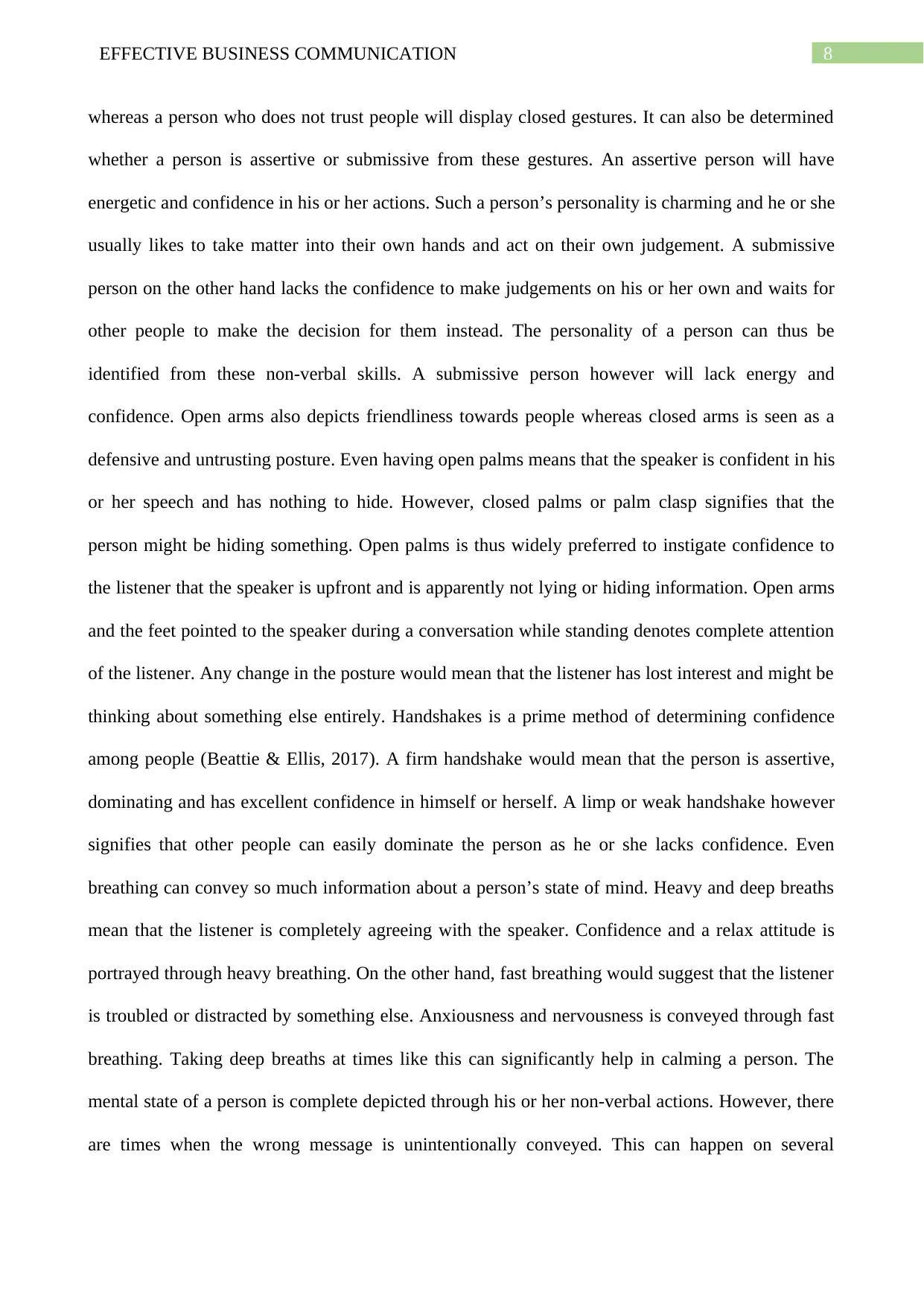
8EFFECTIVE BUSINESS COMMUNICATION
whereas a person who does not trust people will display closed gestures. It can also be determined
whether a person is assertive or submissive from these gestures. An assertive person will have
energetic and confidence in his or her actions. Such a person’s personality is charming and he or she
usually likes to take matter into their own hands and act on their own judgement. A submissive
person on the other hand lacks the confidence to make judgements on his or her own and waits for
other people to make the decision for them instead. The personality of a person can thus be
identified from these non-verbal skills. A submissive person however will lack energy and
confidence. Open arms also depicts friendliness towards people whereas closed arms is seen as a
defensive and untrusting posture. Even having open palms means that the speaker is confident in his
or her speech and has nothing to hide. However, closed palms or palm clasp signifies that the
person might be hiding something. Open palms is thus widely preferred to instigate confidence to
the listener that the speaker is upfront and is apparently not lying or hiding information. Open arms
and the feet pointed to the speaker during a conversation while standing denotes complete attention
of the listener. Any change in the posture would mean that the listener has lost interest and might be
thinking about something else entirely. Handshakes is a prime method of determining confidence
among people (Beattie & Ellis, 2017). A firm handshake would mean that the person is assertive,
dominating and has excellent confidence in himself or herself. A limp or weak handshake however
signifies that other people can easily dominate the person as he or she lacks confidence. Even
breathing can convey so much information about a person’s state of mind. Heavy and deep breaths
mean that the listener is completely agreeing with the speaker. Confidence and a relax attitude is
portrayed through heavy breathing. On the other hand, fast breathing would suggest that the listener
is troubled or distracted by something else. Anxiousness and nervousness is conveyed through fast
breathing. Taking deep breaths at times like this can significantly help in calming a person. The
mental state of a person is complete depicted through his or her non-verbal actions. However, there
are times when the wrong message is unintentionally conveyed. This can happen on several
whereas a person who does not trust people will display closed gestures. It can also be determined
whether a person is assertive or submissive from these gestures. An assertive person will have
energetic and confidence in his or her actions. Such a person’s personality is charming and he or she
usually likes to take matter into their own hands and act on their own judgement. A submissive
person on the other hand lacks the confidence to make judgements on his or her own and waits for
other people to make the decision for them instead. The personality of a person can thus be
identified from these non-verbal skills. A submissive person however will lack energy and
confidence. Open arms also depicts friendliness towards people whereas closed arms is seen as a
defensive and untrusting posture. Even having open palms means that the speaker is confident in his
or her speech and has nothing to hide. However, closed palms or palm clasp signifies that the
person might be hiding something. Open palms is thus widely preferred to instigate confidence to
the listener that the speaker is upfront and is apparently not lying or hiding information. Open arms
and the feet pointed to the speaker during a conversation while standing denotes complete attention
of the listener. Any change in the posture would mean that the listener has lost interest and might be
thinking about something else entirely. Handshakes is a prime method of determining confidence
among people (Beattie & Ellis, 2017). A firm handshake would mean that the person is assertive,
dominating and has excellent confidence in himself or herself. A limp or weak handshake however
signifies that other people can easily dominate the person as he or she lacks confidence. Even
breathing can convey so much information about a person’s state of mind. Heavy and deep breaths
mean that the listener is completely agreeing with the speaker. Confidence and a relax attitude is
portrayed through heavy breathing. On the other hand, fast breathing would suggest that the listener
is troubled or distracted by something else. Anxiousness and nervousness is conveyed through fast
breathing. Taking deep breaths at times like this can significantly help in calming a person. The
mental state of a person is complete depicted through his or her non-verbal actions. However, there
are times when the wrong message is unintentionally conveyed. This can happen on several
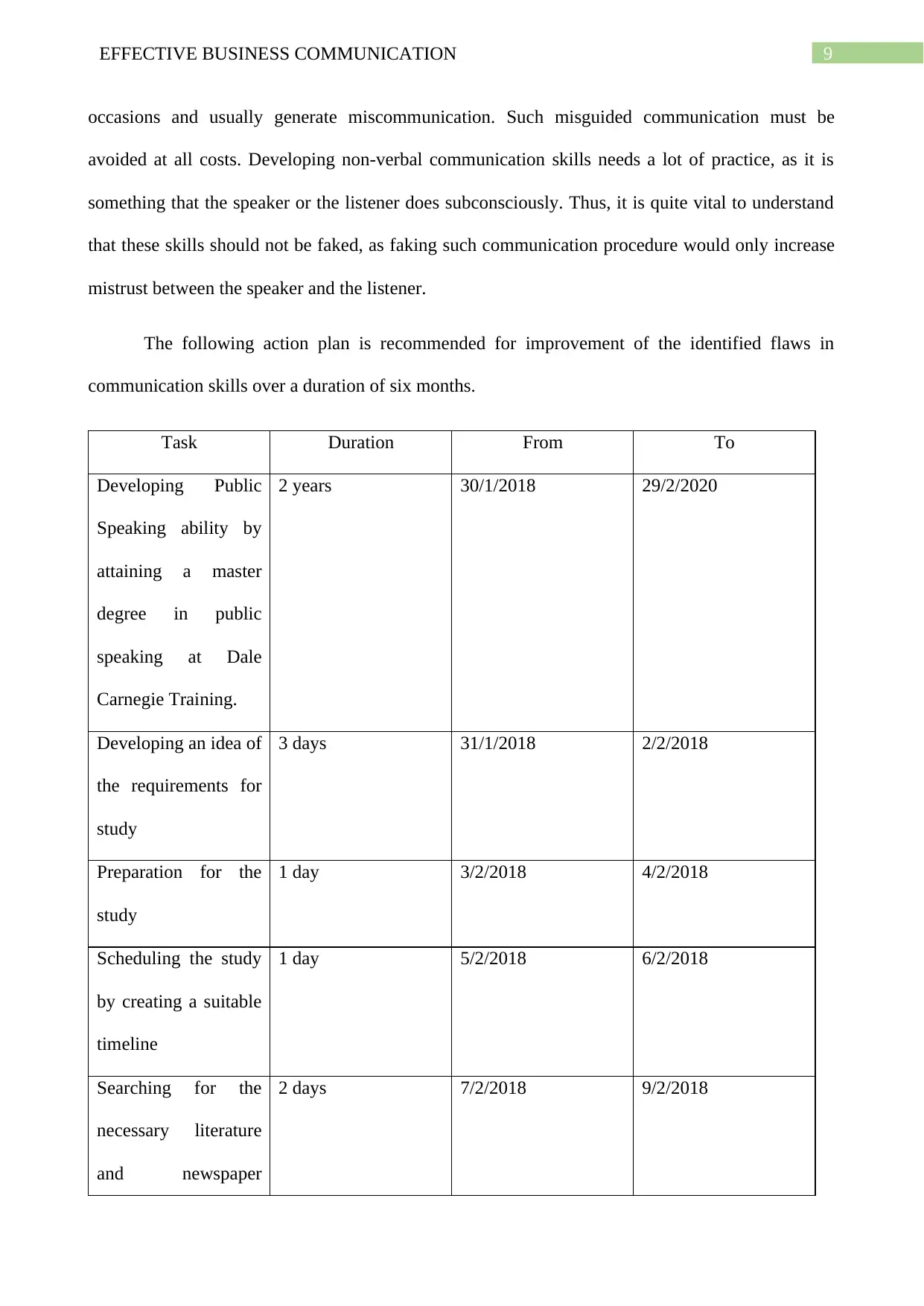
9EFFECTIVE BUSINESS COMMUNICATION
occasions and usually generate miscommunication. Such misguided communication must be
avoided at all costs. Developing non-verbal communication skills needs a lot of practice, as it is
something that the speaker or the listener does subconsciously. Thus, it is quite vital to understand
that these skills should not be faked, as faking such communication procedure would only increase
mistrust between the speaker and the listener.
The following action plan is recommended for improvement of the identified flaws in
communication skills over a duration of six months.
Task Duration From To
Developing Public
Speaking ability by
attaining a master
degree in public
speaking at Dale
Carnegie Training.
2 years 30/1/2018 29/2/2020
Developing an idea of
the requirements for
study
3 days 31/1/2018 2/2/2018
Preparation for the
study
1 day 3/2/2018 4/2/2018
Scheduling the study
by creating a suitable
timeline
1 day 5/2/2018 6/2/2018
Searching for the
necessary literature
and newspaper
2 days 7/2/2018 9/2/2018
occasions and usually generate miscommunication. Such misguided communication must be
avoided at all costs. Developing non-verbal communication skills needs a lot of practice, as it is
something that the speaker or the listener does subconsciously. Thus, it is quite vital to understand
that these skills should not be faked, as faking such communication procedure would only increase
mistrust between the speaker and the listener.
The following action plan is recommended for improvement of the identified flaws in
communication skills over a duration of six months.
Task Duration From To
Developing Public
Speaking ability by
attaining a master
degree in public
speaking at Dale
Carnegie Training.
2 years 30/1/2018 29/2/2020
Developing an idea of
the requirements for
study
3 days 31/1/2018 2/2/2018
Preparation for the
study
1 day 3/2/2018 4/2/2018
Scheduling the study
by creating a suitable
timeline
1 day 5/2/2018 6/2/2018
Searching for the
necessary literature
and newspaper
2 days 7/2/2018 9/2/2018
Secure Best Marks with AI Grader
Need help grading? Try our AI Grader for instant feedback on your assignments.
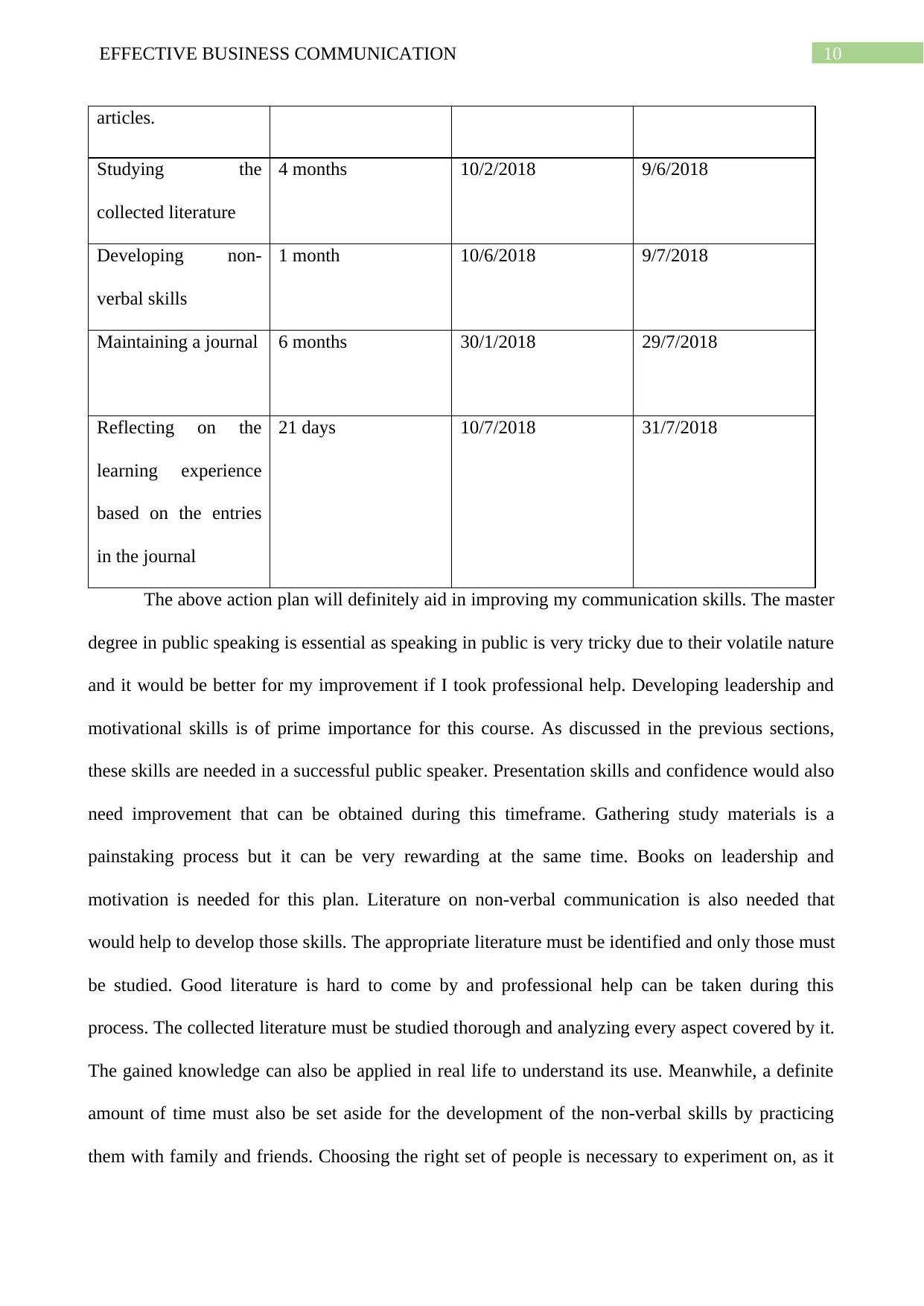
10EFFECTIVE BUSINESS COMMUNICATION
articles.
Studying the
collected literature
4 months 10/2/2018 9/6/2018
Developing non-
verbal skills
1 month 10/6/2018 9/7/2018
Maintaining a journal 6 months 30/1/2018 29/7/2018
Reflecting on the
learning experience
based on the entries
in the journal
21 days 10/7/2018 31/7/2018
The above action plan will definitely aid in improving my communication skills. The master
degree in public speaking is essential as speaking in public is very tricky due to their volatile nature
and it would be better for my improvement if I took professional help. Developing leadership and
motivational skills is of prime importance for this course. As discussed in the previous sections,
these skills are needed in a successful public speaker. Presentation skills and confidence would also
need improvement that can be obtained during this timeframe. Gathering study materials is a
painstaking process but it can be very rewarding at the same time. Books on leadership and
motivation is needed for this plan. Literature on non-verbal communication is also needed that
would help to develop those skills. The appropriate literature must be identified and only those must
be studied. Good literature is hard to come by and professional help can be taken during this
process. The collected literature must be studied thorough and analyzing every aspect covered by it.
The gained knowledge can also be applied in real life to understand its use. Meanwhile, a definite
amount of time must also be set aside for the development of the non-verbal skills by practicing
them with family and friends. Choosing the right set of people is necessary to experiment on, as it
articles.
Studying the
collected literature
4 months 10/2/2018 9/6/2018
Developing non-
verbal skills
1 month 10/6/2018 9/7/2018
Maintaining a journal 6 months 30/1/2018 29/7/2018
Reflecting on the
learning experience
based on the entries
in the journal
21 days 10/7/2018 31/7/2018
The above action plan will definitely aid in improving my communication skills. The master
degree in public speaking is essential as speaking in public is very tricky due to their volatile nature
and it would be better for my improvement if I took professional help. Developing leadership and
motivational skills is of prime importance for this course. As discussed in the previous sections,
these skills are needed in a successful public speaker. Presentation skills and confidence would also
need improvement that can be obtained during this timeframe. Gathering study materials is a
painstaking process but it can be very rewarding at the same time. Books on leadership and
motivation is needed for this plan. Literature on non-verbal communication is also needed that
would help to develop those skills. The appropriate literature must be identified and only those must
be studied. Good literature is hard to come by and professional help can be taken during this
process. The collected literature must be studied thorough and analyzing every aspect covered by it.
The gained knowledge can also be applied in real life to understand its use. Meanwhile, a definite
amount of time must also be set aside for the development of the non-verbal skills by practicing
them with family and friends. Choosing the right set of people is necessary to experiment on, as it
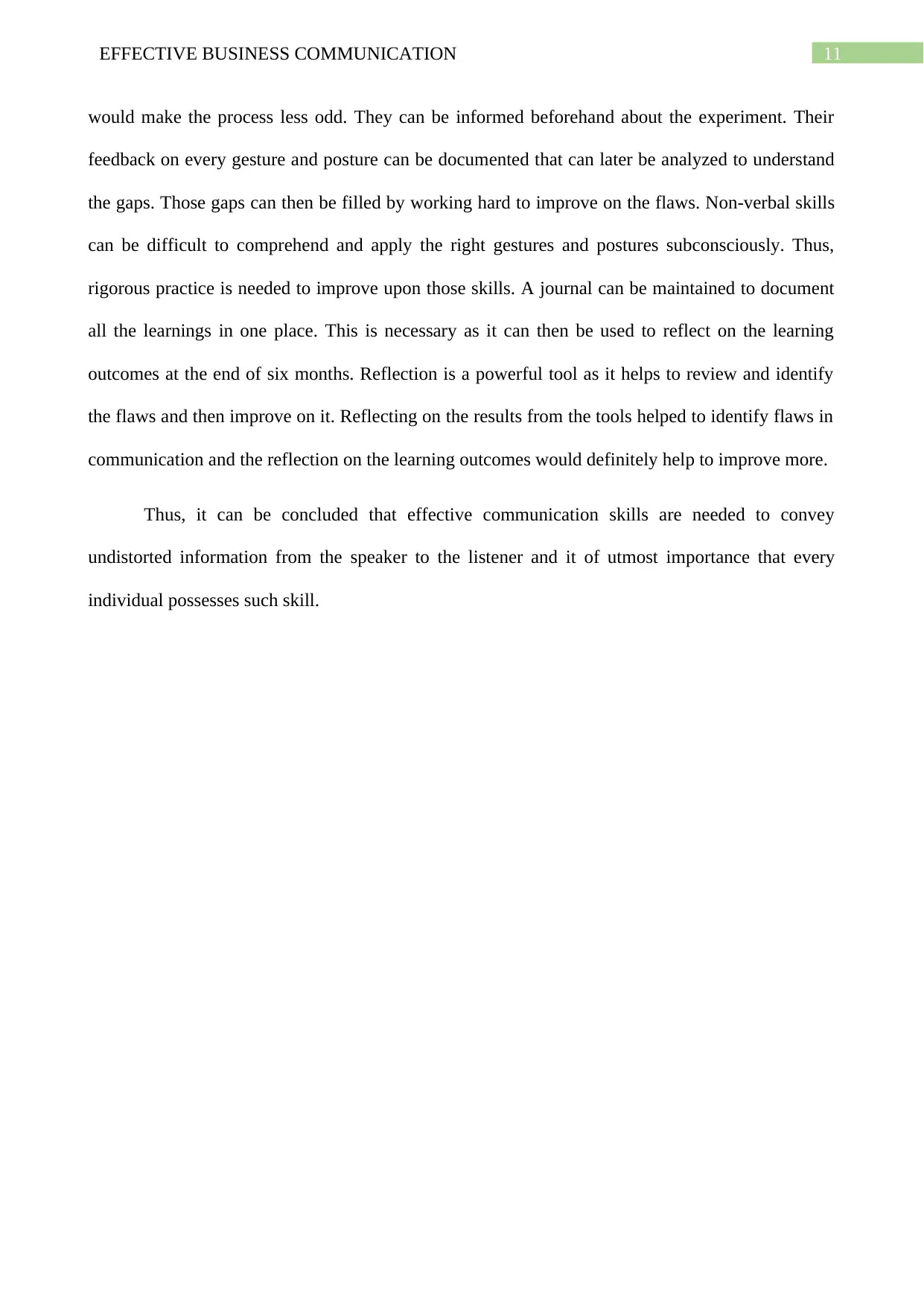
11EFFECTIVE BUSINESS COMMUNICATION
would make the process less odd. They can be informed beforehand about the experiment. Their
feedback on every gesture and posture can be documented that can later be analyzed to understand
the gaps. Those gaps can then be filled by working hard to improve on the flaws. Non-verbal skills
can be difficult to comprehend and apply the right gestures and postures subconsciously. Thus,
rigorous practice is needed to improve upon those skills. A journal can be maintained to document
all the learnings in one place. This is necessary as it can then be used to reflect on the learning
outcomes at the end of six months. Reflection is a powerful tool as it helps to review and identify
the flaws and then improve on it. Reflecting on the results from the tools helped to identify flaws in
communication and the reflection on the learning outcomes would definitely help to improve more.
Thus, it can be concluded that effective communication skills are needed to convey
undistorted information from the speaker to the listener and it of utmost importance that every
individual possesses such skill.
would make the process less odd. They can be informed beforehand about the experiment. Their
feedback on every gesture and posture can be documented that can later be analyzed to understand
the gaps. Those gaps can then be filled by working hard to improve on the flaws. Non-verbal skills
can be difficult to comprehend and apply the right gestures and postures subconsciously. Thus,
rigorous practice is needed to improve upon those skills. A journal can be maintained to document
all the learnings in one place. This is necessary as it can then be used to reflect on the learning
outcomes at the end of six months. Reflection is a powerful tool as it helps to review and identify
the flaws and then improve on it. Reflecting on the results from the tools helped to identify flaws in
communication and the reflection on the learning outcomes would definitely help to improve more.
Thus, it can be concluded that effective communication skills are needed to convey
undistorted information from the speaker to the listener and it of utmost importance that every
individual possesses such skill.
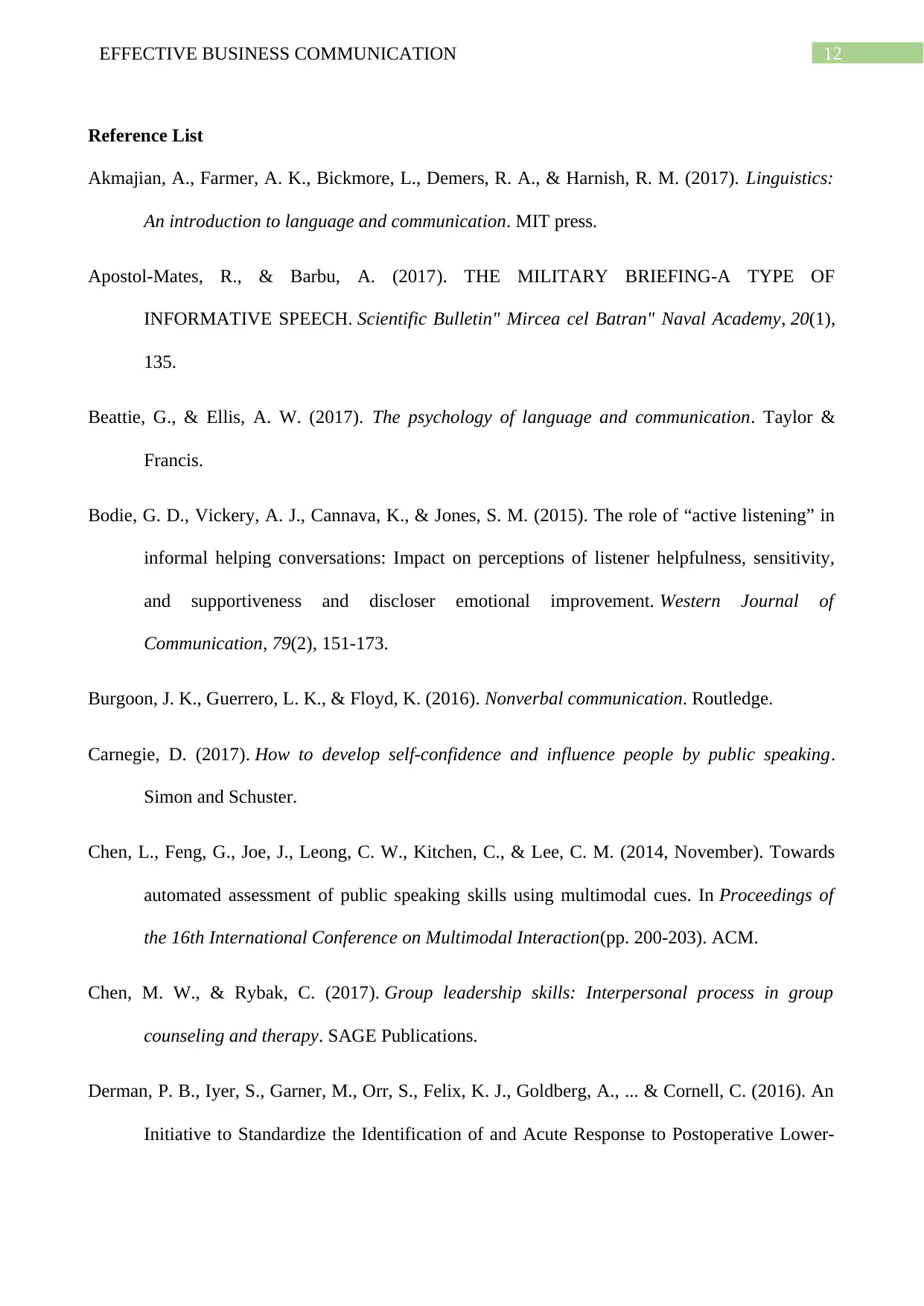
12EFFECTIVE BUSINESS COMMUNICATION
Reference List
Akmajian, A., Farmer, A. K., Bickmore, L., Demers, R. A., & Harnish, R. M. (2017). Linguistics:
An introduction to language and communication. MIT press.
Apostol-Mates, R., & Barbu, A. (2017). THE MILITARY BRIEFING-A TYPE OF
INFORMATIVE SPEECH. Scientific Bulletin" Mircea cel Batran" Naval Academy, 20(1),
135.
Beattie, G., & Ellis, A. W. (2017). The psychology of language and communication. Taylor &
Francis.
Bodie, G. D., Vickery, A. J., Cannava, K., & Jones, S. M. (2015). The role of “active listening” in
informal helping conversations: Impact on perceptions of listener helpfulness, sensitivity,
and supportiveness and discloser emotional improvement. Western Journal of
Communication, 79(2), 151-173.
Burgoon, J. K., Guerrero, L. K., & Floyd, K. (2016). Nonverbal communication. Routledge.
Carnegie, D. (2017). How to develop self-confidence and influence people by public speaking.
Simon and Schuster.
Chen, L., Feng, G., Joe, J., Leong, C. W., Kitchen, C., & Lee, C. M. (2014, November). Towards
automated assessment of public speaking skills using multimodal cues. In Proceedings of
the 16th International Conference on Multimodal Interaction(pp. 200-203). ACM.
Chen, M. W., & Rybak, C. (2017). Group leadership skills: Interpersonal process in group
counseling and therapy. SAGE Publications.
Derman, P. B., Iyer, S., Garner, M., Orr, S., Felix, K. J., Goldberg, A., ... & Cornell, C. (2016). An
Initiative to Standardize the Identification of and Acute Response to Postoperative Lower-
Reference List
Akmajian, A., Farmer, A. K., Bickmore, L., Demers, R. A., & Harnish, R. M. (2017). Linguistics:
An introduction to language and communication. MIT press.
Apostol-Mates, R., & Barbu, A. (2017). THE MILITARY BRIEFING-A TYPE OF
INFORMATIVE SPEECH. Scientific Bulletin" Mircea cel Batran" Naval Academy, 20(1),
135.
Beattie, G., & Ellis, A. W. (2017). The psychology of language and communication. Taylor &
Francis.
Bodie, G. D., Vickery, A. J., Cannava, K., & Jones, S. M. (2015). The role of “active listening” in
informal helping conversations: Impact on perceptions of listener helpfulness, sensitivity,
and supportiveness and discloser emotional improvement. Western Journal of
Communication, 79(2), 151-173.
Burgoon, J. K., Guerrero, L. K., & Floyd, K. (2016). Nonverbal communication. Routledge.
Carnegie, D. (2017). How to develop self-confidence and influence people by public speaking.
Simon and Schuster.
Chen, L., Feng, G., Joe, J., Leong, C. W., Kitchen, C., & Lee, C. M. (2014, November). Towards
automated assessment of public speaking skills using multimodal cues. In Proceedings of
the 16th International Conference on Multimodal Interaction(pp. 200-203). ACM.
Chen, M. W., & Rybak, C. (2017). Group leadership skills: Interpersonal process in group
counseling and therapy. SAGE Publications.
Derman, P. B., Iyer, S., Garner, M., Orr, S., Felix, K. J., Goldberg, A., ... & Cornell, C. (2016). An
Initiative to Standardize the Identification of and Acute Response to Postoperative Lower-
Paraphrase This Document
Need a fresh take? Get an instant paraphrase of this document with our AI Paraphraser
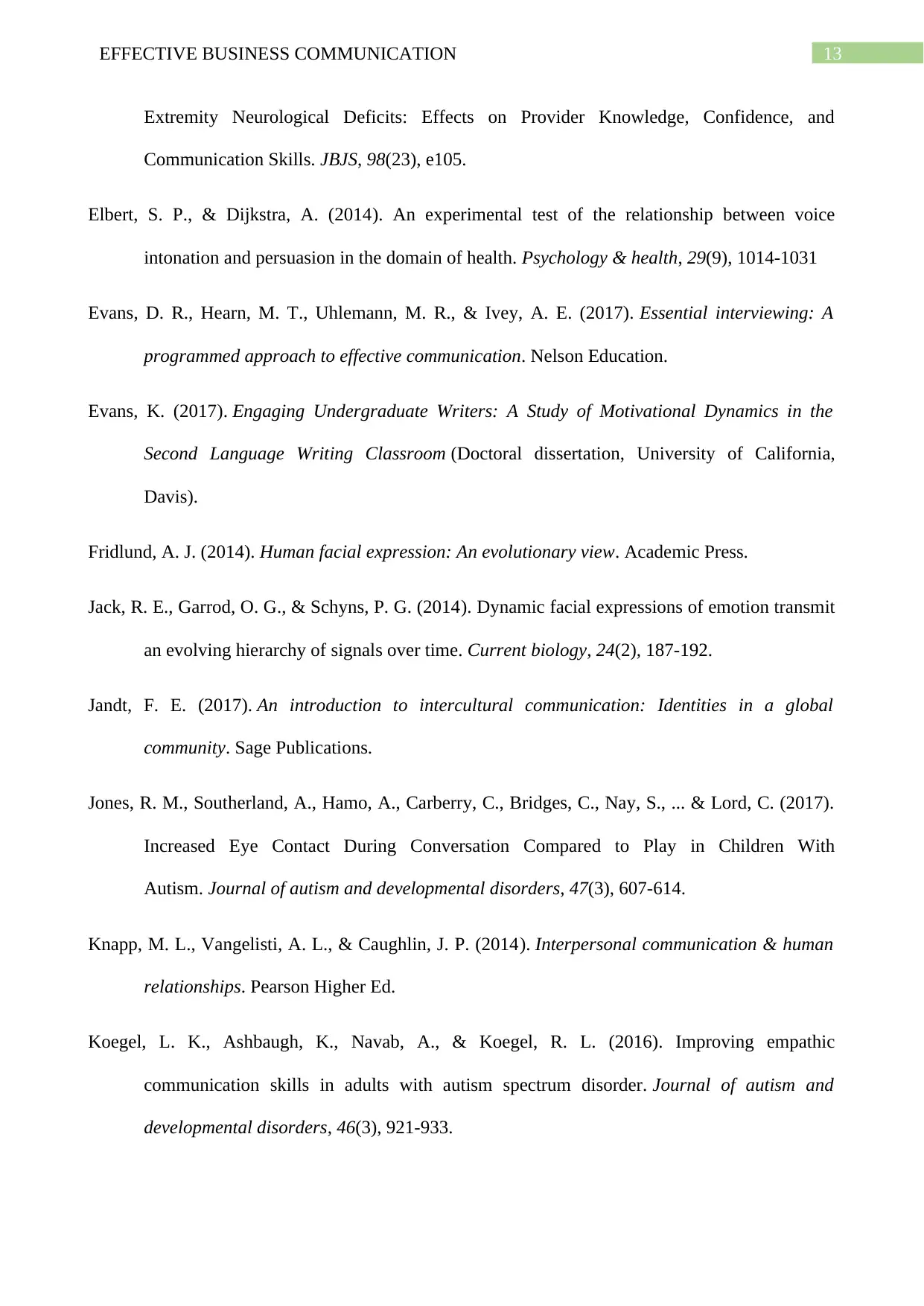
13EFFECTIVE BUSINESS COMMUNICATION
Extremity Neurological Deficits: Effects on Provider Knowledge, Confidence, and
Communication Skills. JBJS, 98(23), e105.
Elbert, S. P., & Dijkstra, A. (2014). An experimental test of the relationship between voice
intonation and persuasion in the domain of health. Psychology & health, 29(9), 1014-1031
Evans, D. R., Hearn, M. T., Uhlemann, M. R., & Ivey, A. E. (2017). Essential interviewing: A
programmed approach to effective communication. Nelson Education.
Evans, K. (2017). Engaging Undergraduate Writers: A Study of Motivational Dynamics in the
Second Language Writing Classroom (Doctoral dissertation, University of California,
Davis).
Fridlund, A. J. (2014). Human facial expression: An evolutionary view. Academic Press.
Jack, R. E., Garrod, O. G., & Schyns, P. G. (2014). Dynamic facial expressions of emotion transmit
an evolving hierarchy of signals over time. Current biology, 24(2), 187-192.
Jandt, F. E. (2017). An introduction to intercultural communication: Identities in a global
community. Sage Publications.
Jones, R. M., Southerland, A., Hamo, A., Carberry, C., Bridges, C., Nay, S., ... & Lord, C. (2017).
Increased Eye Contact During Conversation Compared to Play in Children With
Autism. Journal of autism and developmental disorders, 47(3), 607-614.
Knapp, M. L., Vangelisti, A. L., & Caughlin, J. P. (2014). Interpersonal communication & human
relationships. Pearson Higher Ed.
Koegel, L. K., Ashbaugh, K., Navab, A., & Koegel, R. L. (2016). Improving empathic
communication skills in adults with autism spectrum disorder. Journal of autism and
developmental disorders, 46(3), 921-933.
Extremity Neurological Deficits: Effects on Provider Knowledge, Confidence, and
Communication Skills. JBJS, 98(23), e105.
Elbert, S. P., & Dijkstra, A. (2014). An experimental test of the relationship between voice
intonation and persuasion in the domain of health. Psychology & health, 29(9), 1014-1031
Evans, D. R., Hearn, M. T., Uhlemann, M. R., & Ivey, A. E. (2017). Essential interviewing: A
programmed approach to effective communication. Nelson Education.
Evans, K. (2017). Engaging Undergraduate Writers: A Study of Motivational Dynamics in the
Second Language Writing Classroom (Doctoral dissertation, University of California,
Davis).
Fridlund, A. J. (2014). Human facial expression: An evolutionary view. Academic Press.
Jack, R. E., Garrod, O. G., & Schyns, P. G. (2014). Dynamic facial expressions of emotion transmit
an evolving hierarchy of signals over time. Current biology, 24(2), 187-192.
Jandt, F. E. (2017). An introduction to intercultural communication: Identities in a global
community. Sage Publications.
Jones, R. M., Southerland, A., Hamo, A., Carberry, C., Bridges, C., Nay, S., ... & Lord, C. (2017).
Increased Eye Contact During Conversation Compared to Play in Children With
Autism. Journal of autism and developmental disorders, 47(3), 607-614.
Knapp, M. L., Vangelisti, A. L., & Caughlin, J. P. (2014). Interpersonal communication & human
relationships. Pearson Higher Ed.
Koegel, L. K., Ashbaugh, K., Navab, A., & Koegel, R. L. (2016). Improving empathic
communication skills in adults with autism spectrum disorder. Journal of autism and
developmental disorders, 46(3), 921-933.
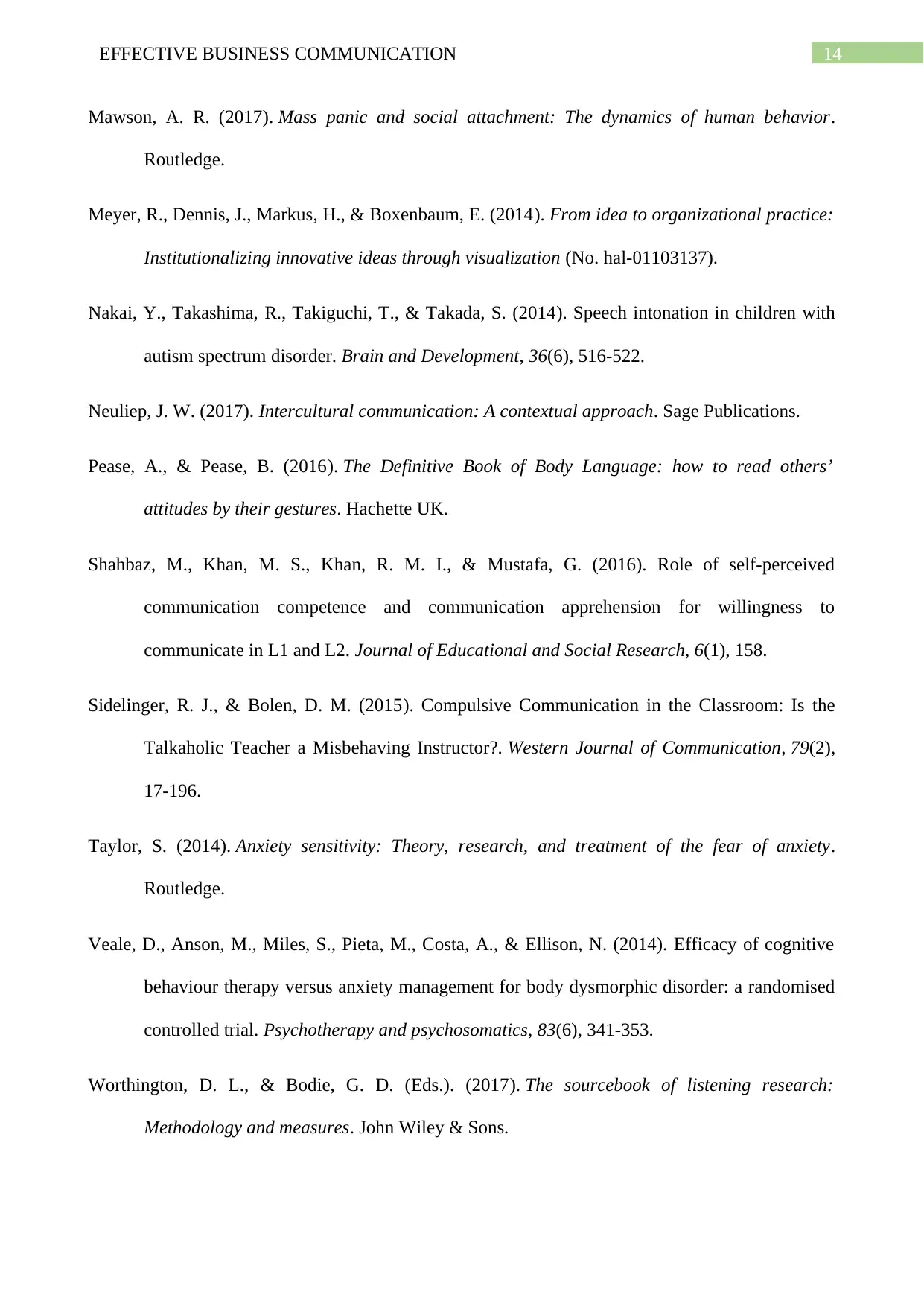
14EFFECTIVE BUSINESS COMMUNICATION
Mawson, A. R. (2017). Mass panic and social attachment: The dynamics of human behavior.
Routledge.
Meyer, R., Dennis, J., Markus, H., & Boxenbaum, E. (2014). From idea to organizational practice:
Institutionalizing innovative ideas through visualization (No. hal-01103137).
Nakai, Y., Takashima, R., Takiguchi, T., & Takada, S. (2014). Speech intonation in children with
autism spectrum disorder. Brain and Development, 36(6), 516-522.
Neuliep, J. W. (2017). Intercultural communication: A contextual approach. Sage Publications.
Pease, A., & Pease, B. (2016). The Definitive Book of Body Language: how to read others’
attitudes by their gestures. Hachette UK.
Shahbaz, M., Khan, M. S., Khan, R. M. I., & Mustafa, G. (2016). Role of self-perceived
communication competence and communication apprehension for willingness to
communicate in L1 and L2. Journal of Educational and Social Research, 6(1), 158.
Sidelinger, R. J., & Bolen, D. M. (2015). Compulsive Communication in the Classroom: Is the
Talkaholic Teacher a Misbehaving Instructor?. Western Journal of Communication, 79(2),
17-196.
Taylor, S. (2014). Anxiety sensitivity: Theory, research, and treatment of the fear of anxiety.
Routledge.
Veale, D., Anson, M., Miles, S., Pieta, M., Costa, A., & Ellison, N. (2014). Efficacy of cognitive
behaviour therapy versus anxiety management for body dysmorphic disorder: a randomised
controlled trial. Psychotherapy and psychosomatics, 83(6), 341-353.
Worthington, D. L., & Bodie, G. D. (Eds.). (2017). The sourcebook of listening research:
Methodology and measures. John Wiley & Sons.
Mawson, A. R. (2017). Mass panic and social attachment: The dynamics of human behavior.
Routledge.
Meyer, R., Dennis, J., Markus, H., & Boxenbaum, E. (2014). From idea to organizational practice:
Institutionalizing innovative ideas through visualization (No. hal-01103137).
Nakai, Y., Takashima, R., Takiguchi, T., & Takada, S. (2014). Speech intonation in children with
autism spectrum disorder. Brain and Development, 36(6), 516-522.
Neuliep, J. W. (2017). Intercultural communication: A contextual approach. Sage Publications.
Pease, A., & Pease, B. (2016). The Definitive Book of Body Language: how to read others’
attitudes by their gestures. Hachette UK.
Shahbaz, M., Khan, M. S., Khan, R. M. I., & Mustafa, G. (2016). Role of self-perceived
communication competence and communication apprehension for willingness to
communicate in L1 and L2. Journal of Educational and Social Research, 6(1), 158.
Sidelinger, R. J., & Bolen, D. M. (2015). Compulsive Communication in the Classroom: Is the
Talkaholic Teacher a Misbehaving Instructor?. Western Journal of Communication, 79(2),
17-196.
Taylor, S. (2014). Anxiety sensitivity: Theory, research, and treatment of the fear of anxiety.
Routledge.
Veale, D., Anson, M., Miles, S., Pieta, M., Costa, A., & Ellison, N. (2014). Efficacy of cognitive
behaviour therapy versus anxiety management for body dysmorphic disorder: a randomised
controlled trial. Psychotherapy and psychosomatics, 83(6), 341-353.
Worthington, D. L., & Bodie, G. D. (Eds.). (2017). The sourcebook of listening research:
Methodology and measures. John Wiley & Sons.
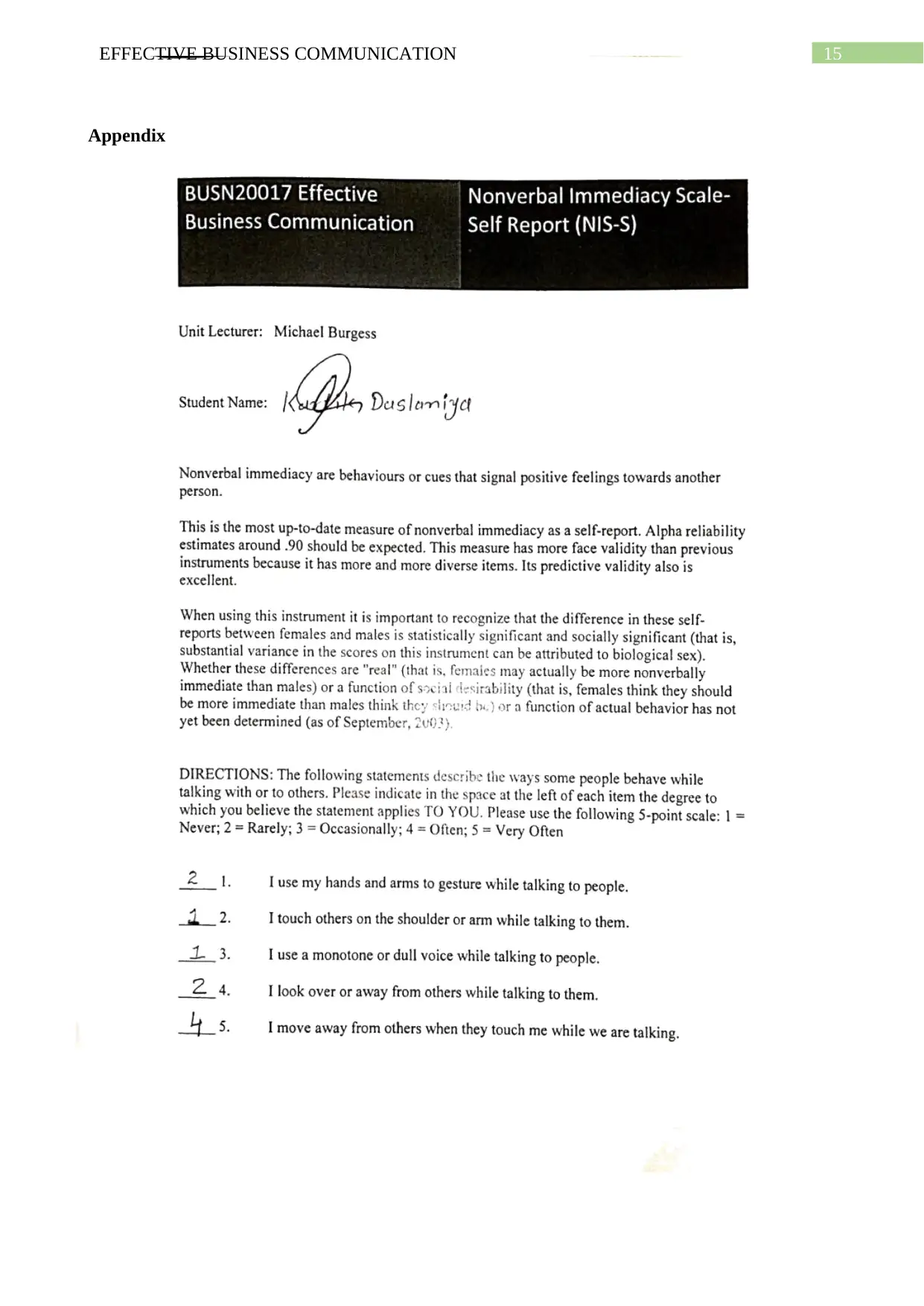
15EFFECTIVE BUSINESS COMMUNICATION
Appendix
Appendix
Secure Best Marks with AI Grader
Need help grading? Try our AI Grader for instant feedback on your assignments.

16EFFECTIVE BUSINESS COMMUNICATION
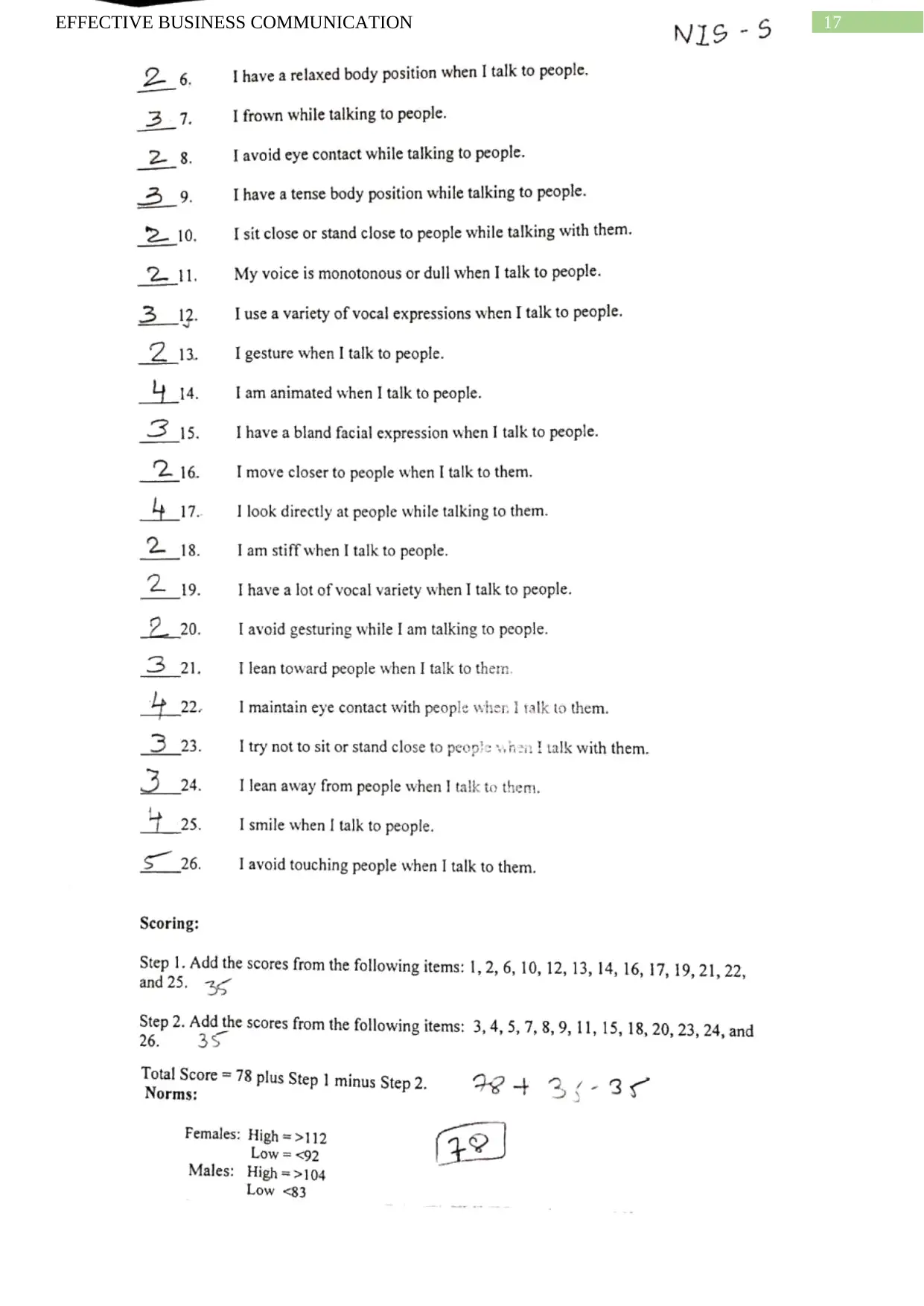
17EFFECTIVE BUSINESS COMMUNICATION
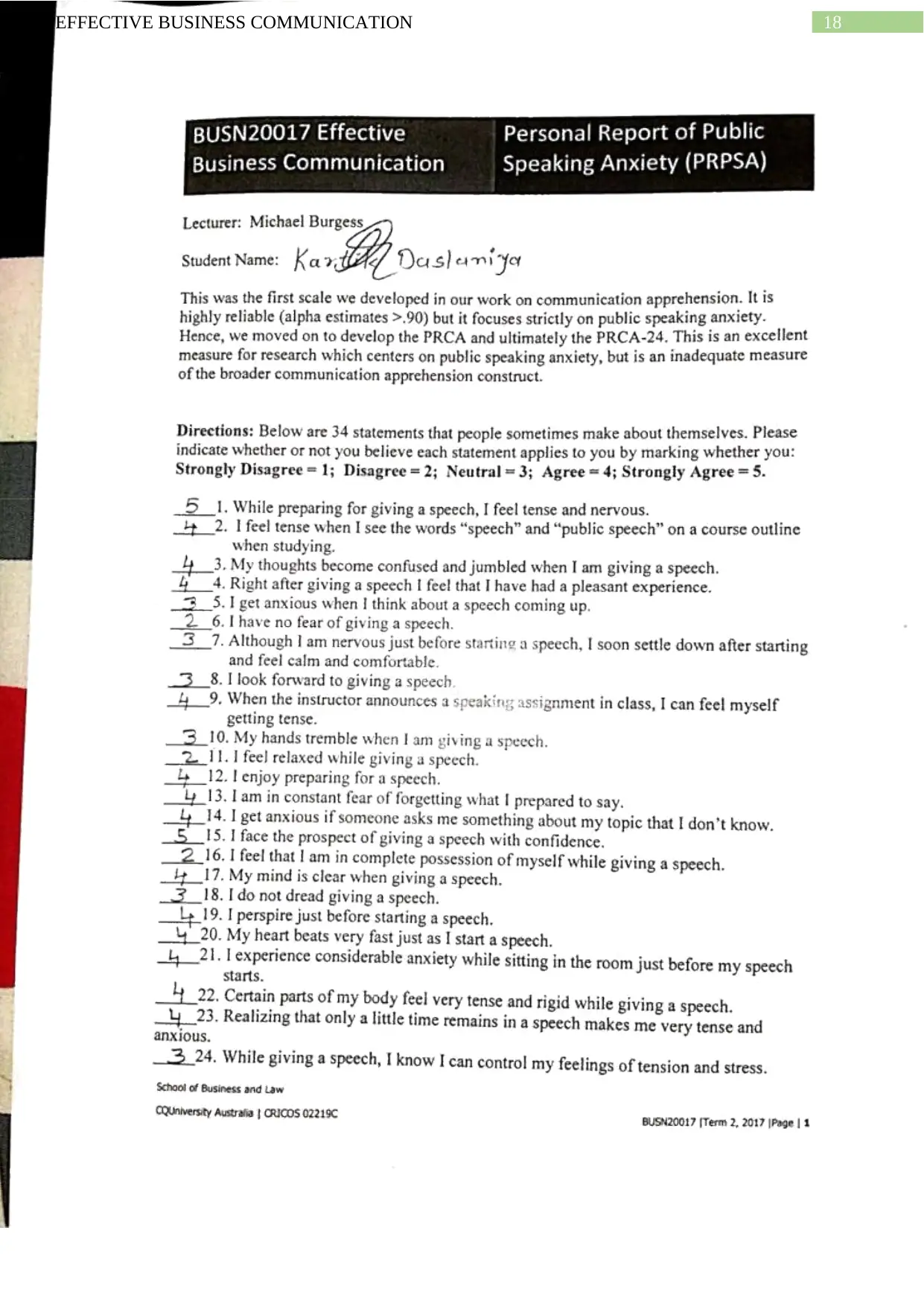
18EFFECTIVE BUSINESS COMMUNICATION
Paraphrase This Document
Need a fresh take? Get an instant paraphrase of this document with our AI Paraphraser
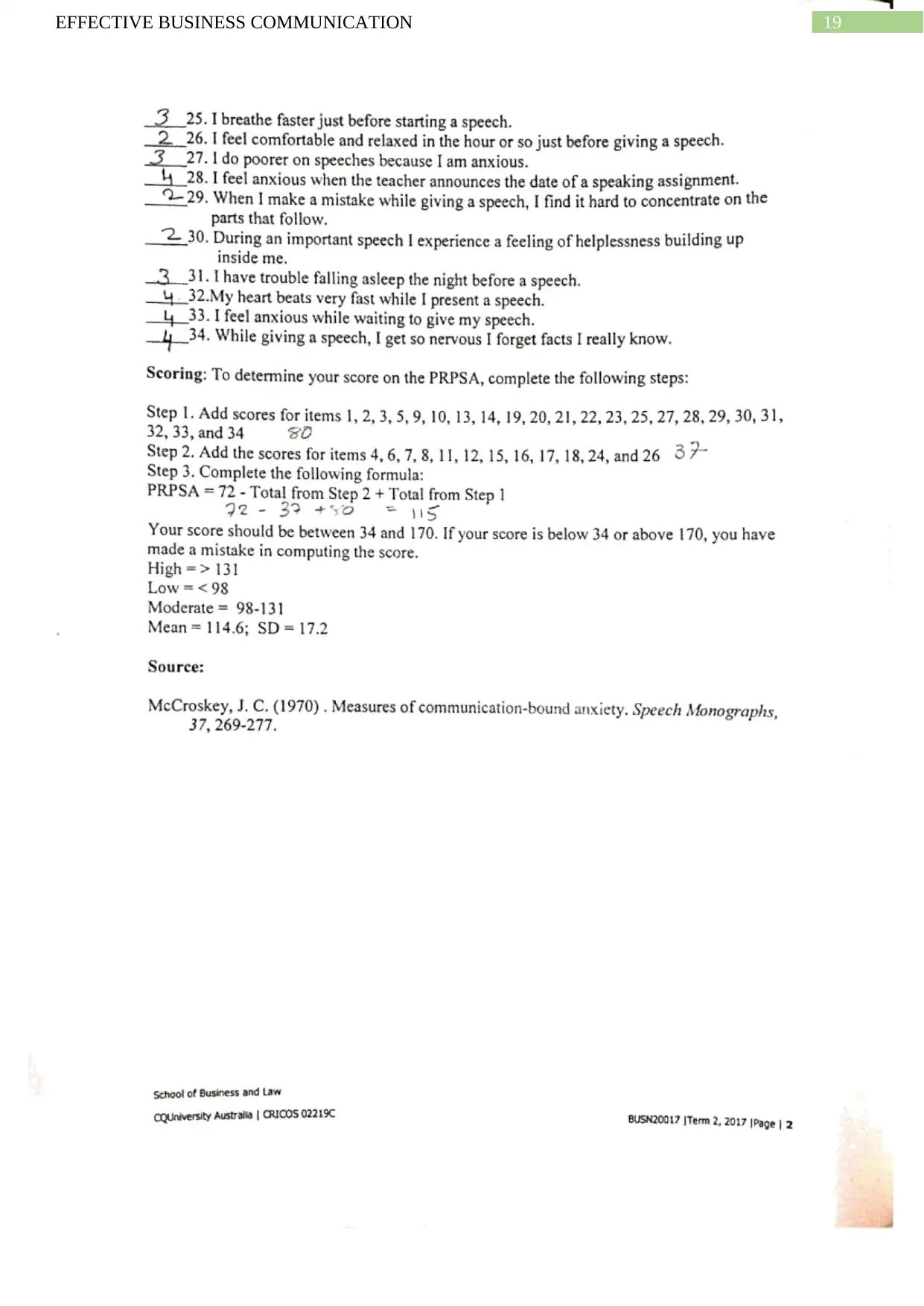
19EFFECTIVE BUSINESS COMMUNICATION
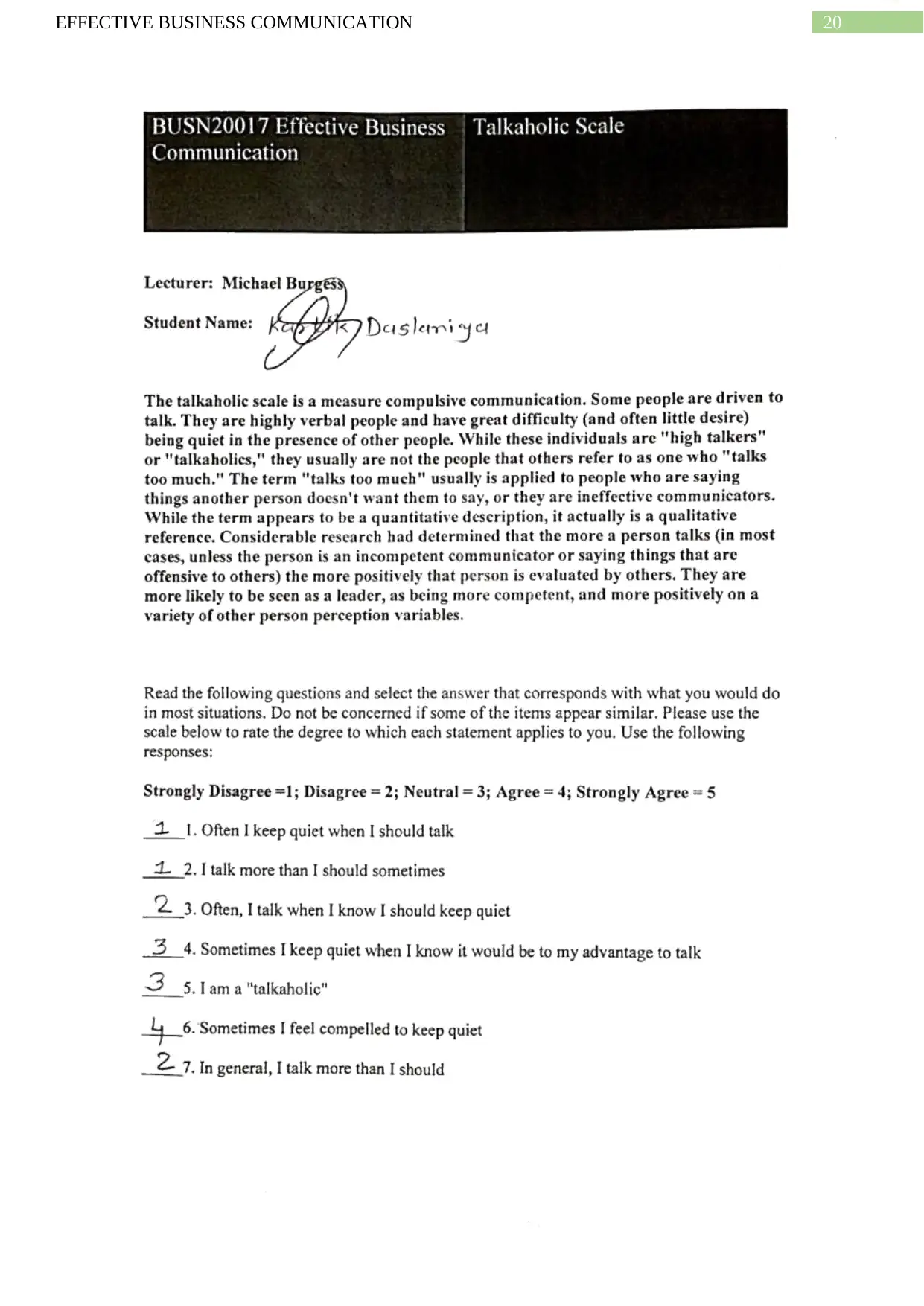
20EFFECTIVE BUSINESS COMMUNICATION
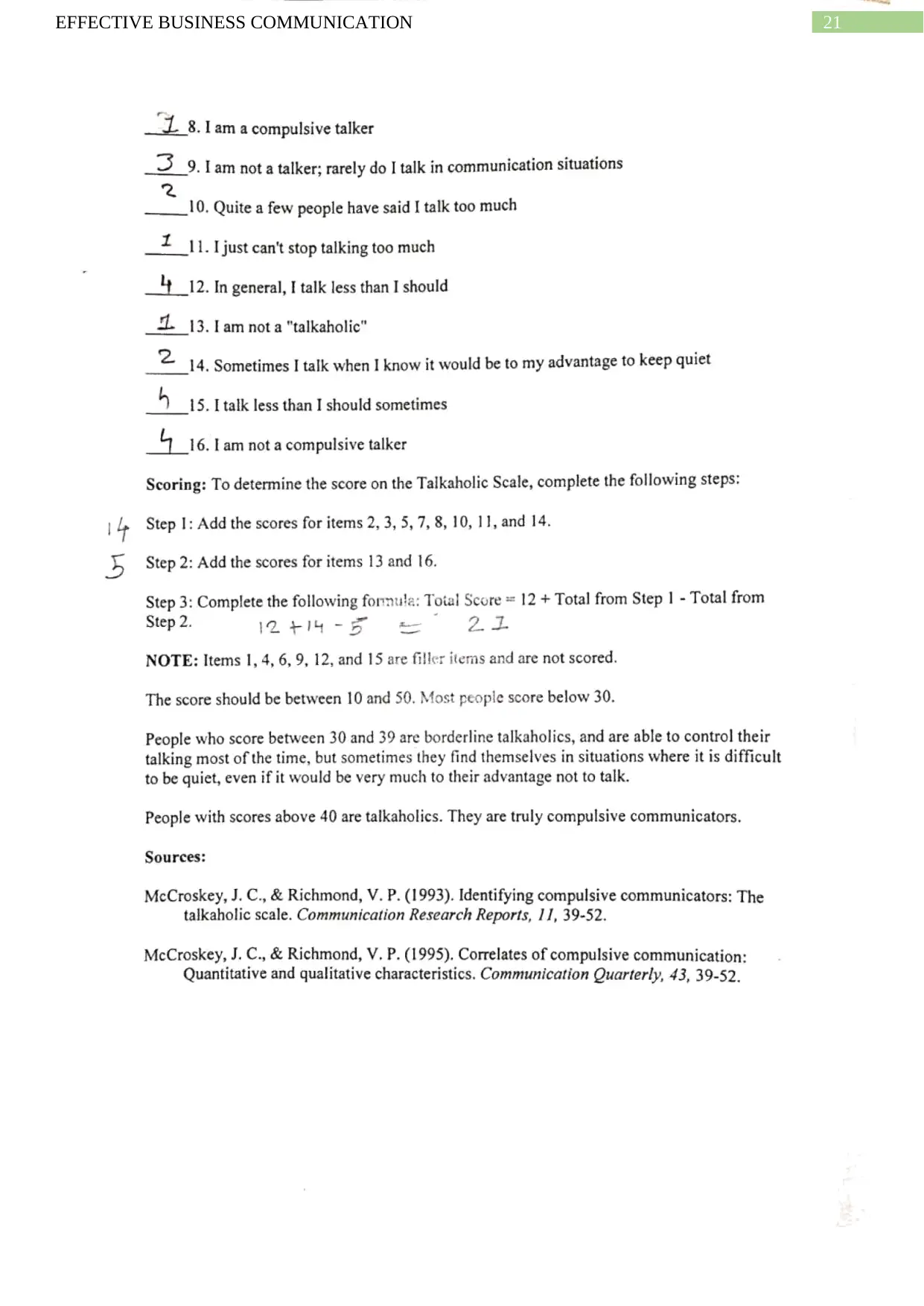
21EFFECTIVE BUSINESS COMMUNICATION
Secure Best Marks with AI Grader
Need help grading? Try our AI Grader for instant feedback on your assignments.
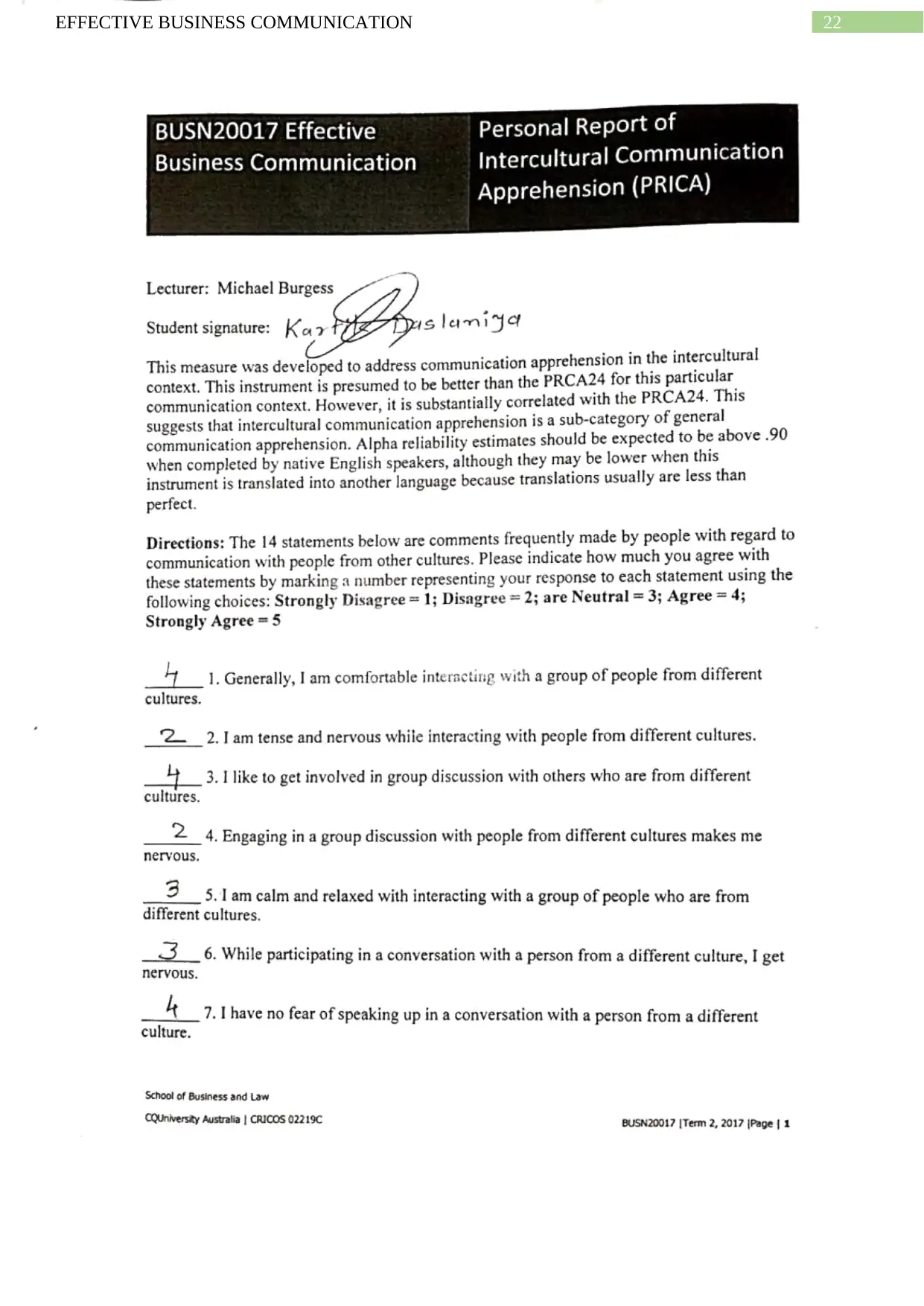
22EFFECTIVE BUSINESS COMMUNICATION
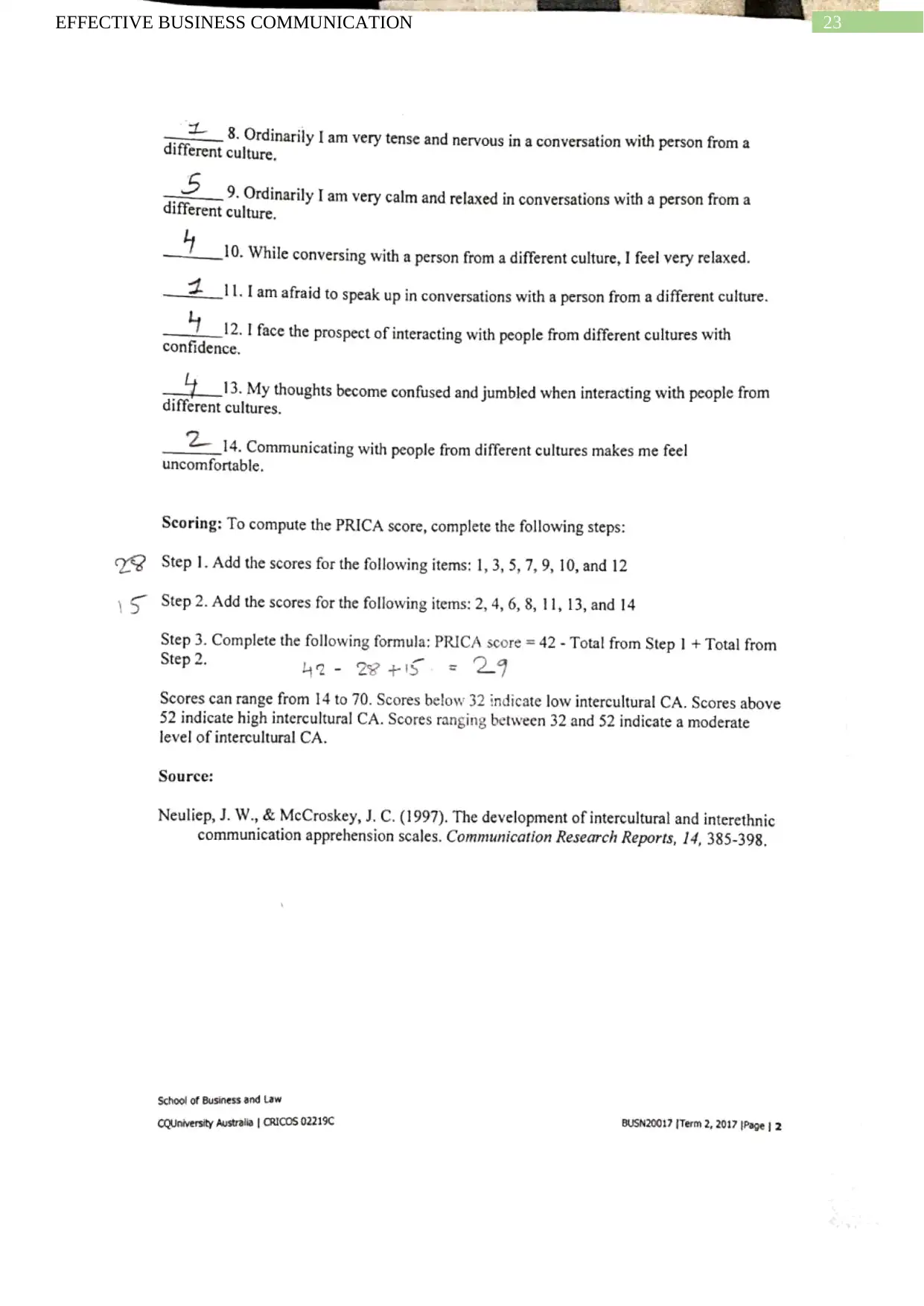
23EFFECTIVE BUSINESS COMMUNICATION
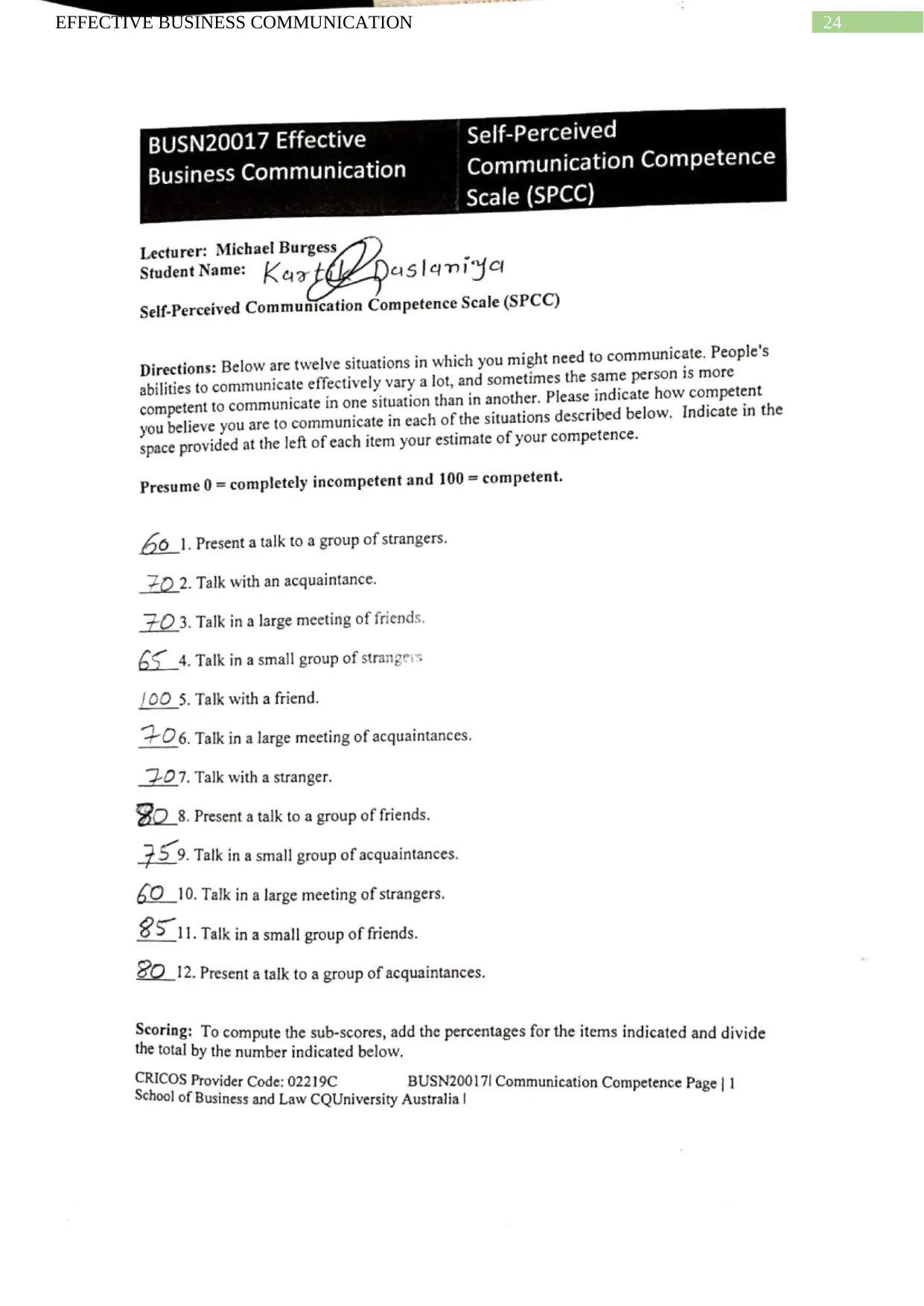
24EFFECTIVE BUSINESS COMMUNICATION
Paraphrase This Document
Need a fresh take? Get an instant paraphrase of this document with our AI Paraphraser
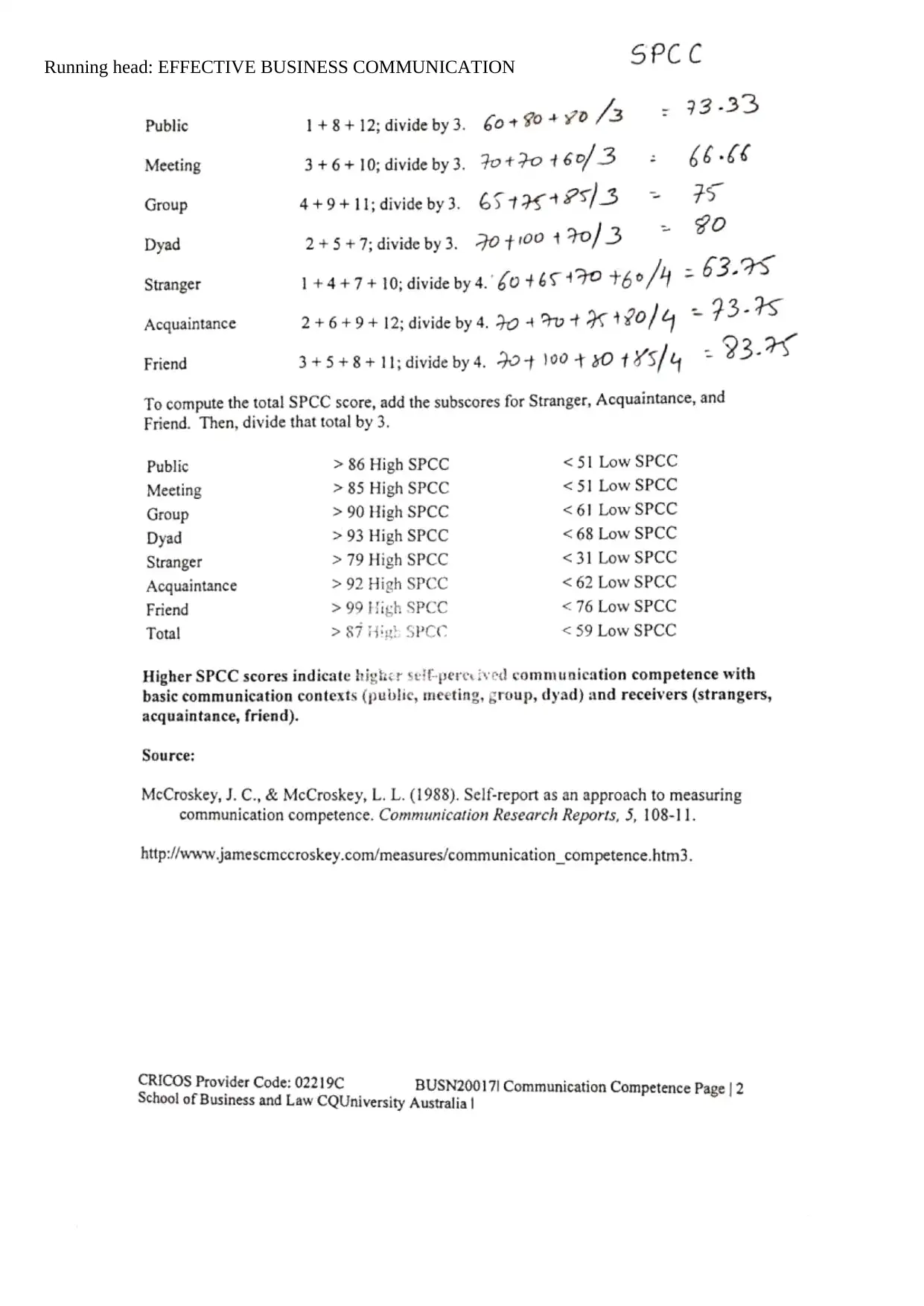
Running head: EFFECTIVE BUSINESS COMMUNICATION
1 out of 26
Related Documents
Your All-in-One AI-Powered Toolkit for Academic Success.
+13062052269
info@desklib.com
Available 24*7 on WhatsApp / Email
![[object Object]](/_next/static/media/star-bottom.7253800d.svg)
Unlock your academic potential
© 2024 | Zucol Services PVT LTD | All rights reserved.





